




Welcome back to another exciting year at CONNECT!
My name is Mike Taylor. I’m the Head Editor for this year’s run of CONNECT. I’m now a JET alumnus, but I spent my first four years in Fukui and transferred to Kanazawa, Ishikawa, last summer. I come from Scotland and have a background in radio journalism. It’s that experience that I hope will be the start of a new era for CONNECT, as we tackle bigger and better stories—your stories—from across Japan.
It’s an absolute pleasure to present the first of the issues for the year, but I’d also like to take a moment to extend some well-deserved thanks to all the members of the team from last year: Your hard work inspired me and many others to take up the mantle. Some of the folk from last year have decided to stick with us, and it’s by their standard that we will live up to and exceed.
However, the person most deserving of an extra shoutout is Dianne Yett. Dianne worked with CONNECT for four years, culminating in a run as the Head Editor last year. Even though she’s gone back home, Dianne has continued to be a foundational support for the CONNECT Team as, in her words, a “helpful goblin.” In a potential first for us, the Head Editing Team this year is made of completely fresh faces, so Dianne has been instrumental in helping us acclimate. Thank you.
There’s a lot to be excited about this year. In the Arts Section, there’s an interview with the founder of Studio Kura, a program for artists across the world to experience rural communities throughout Japan. In the Fashion Section, incoming Fashion Editor Sabrina tackles the naysayers in her article Harajuku is Not Dead.
Meanwhile, in the Community Section, you can read about a retro night cafe in a small Hyogo town while in the Travel Section, you can get the lowdown on all the best places in Gifu to take in the changing color of the leaves—my favourite time of the year in Japan!
There’s more to be excited about than just what’s on the page. This year, the brand new Multimedia Team has been tasked with bringing stories to life outside of this publication. In addition, the results of the photography contest we launched on our Instagram and Facebook pages will be announced later this month, we’ve doubled the size of our social media team, and a podcast is in the works. More details to come on social media pages and website!
Lastly, I’d like to extend a heartfelt thank you to, well, you. Each member of the CONNECT Team volunteers their time to make the best magazine experience we can. We’re thankful for your continued readership. If th2is is your first time reading, thanks for giving it a chance! You won’t be disappointed.
Lang may yer lum reek!

Mike Taylor Head Editor at CONNECT Magazine

Photo by David Spencer
TheArtMagazinewithDifferentFlavorsandToppings: DonMagazine
HiroshimaandKyoto,MesAmours:ALocalDiscussesTwo ofJapan’sMostFamousCitiesandTheirCultures
Hiroshima’sLanternFestival:RememberingThoseLostin theBombing CONNECT|Entertainment
OtherworldlyPassionandUnbridledCelebration:ALook intoComiket
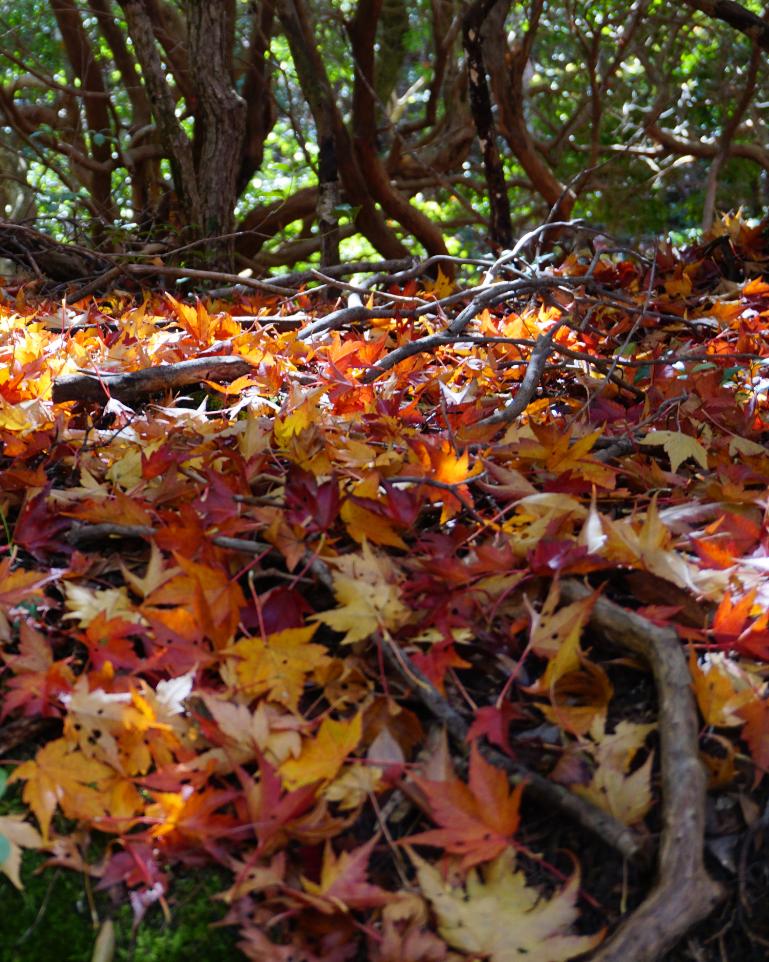
VintageShoppingGetsTech-Savvy:E-Commerceand Japan’sChangingVintageScene
HarajukuIsNotDead
Goals,Discipline,andFriendship:HowIRanaMarathon inJapan
BehindtheClassroomDoor
TheJapanMarketExpansionCompetition
Nokishita:RetroNightCafe,Antiques,andSoba“Underthe “Eaves”
FromHeadlockstoHappyHours:HowaWrestler’sPassion CreatedaOne-of-a-KindBar
HEADEDITOR
MikeTaylor
Baldur’s Gate 3. Bae’Zel forever.
ASSISTANTHEADEDITOR
BrooklynVanderWel
Learning random Japanese words that won’t help me at all in daily life.
ADMINASSISTANT
DianneYett
When am I not obsessing over birds, honestly.
HEADDESIGNER
ReneeStinson
龍が如く. I recently picked up Like a Dragon: Ishin! and I'm having a great time.
TaylorSanders
Learning how to sew plushies. Just bought a book and have saved a ton of Pinterest inspirations and YouTube videos. Eventually I will make the Lawson chicken plushie!!
SECTIONEDITORS
NabeelaBasa
MaritzaDeLaPeña
Been playing a lot of Echoes of Wisdom and watching Culinary Class Wars in my free time.
KiannaShore
Hiking and trying to catch a glimpse of autumn.
AllegraMcCormack
As it’s October, Gravity Falls and Over the Garden Wall have me in their annual chokehold.
ÚnaO'Shea
Panda diplomacy.
SophiaMaas
Lately I’ve been watching a lot of Dimension 20. I can recommend it to anyone who likes tabletop roleplaying games!
ToriBender
Chai lattes and skateboarding constantly. Also really loving Novo Amor’s music for the fall vibes.
ChantalGervais
Moo Deng is life.
SabrinaGreene
I’m DEEP in Spooky Season. My blood is pumpkin spiced, and no one can find me under the 18 layers of sweaters I’m wearing. My best friend is a jack-o-lantern.
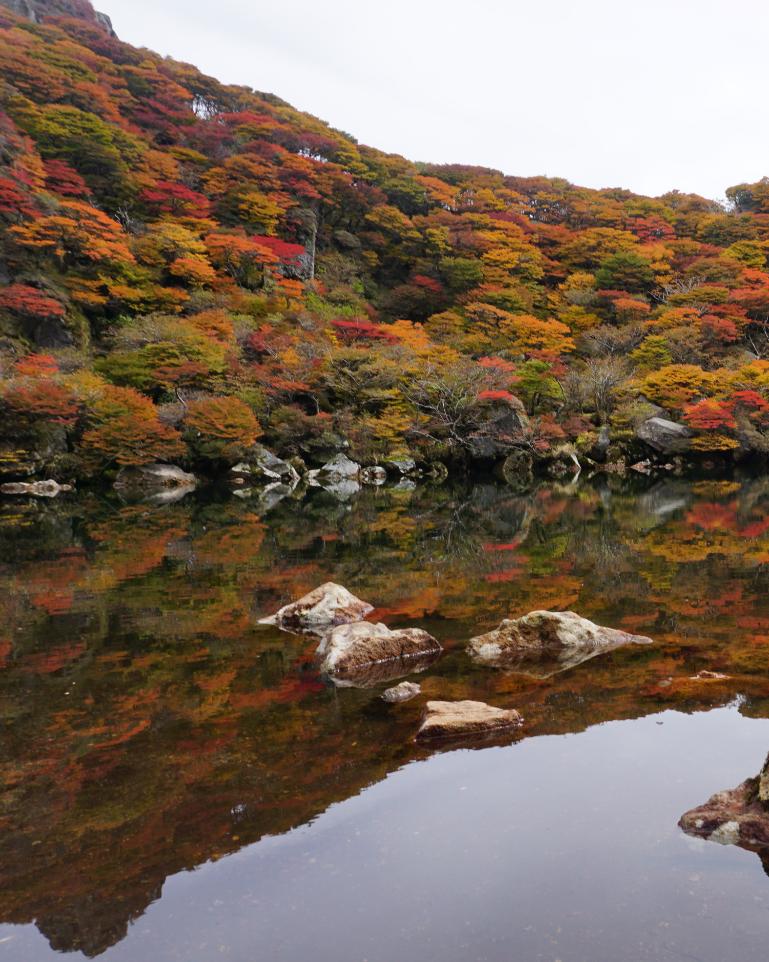
This magazine contains original photos used with permission, as well as free-use images. All included photos are property of the author unless otherwise specified. If you are the owner of an image featured in this publication believed to be used without permission, please contact the Head Designer, Renee Stinson, at visualmedia.connect@ajet.net. This edition and all past editions of AJETCONNECT can be found online at https://connect.ajet.net/category/onlineissues/ or on our website. Read CONNECT online and follow us on ISSUU.
OCTOBER MEET THE TEAM QUESTION: What have you been obsessing over recently?
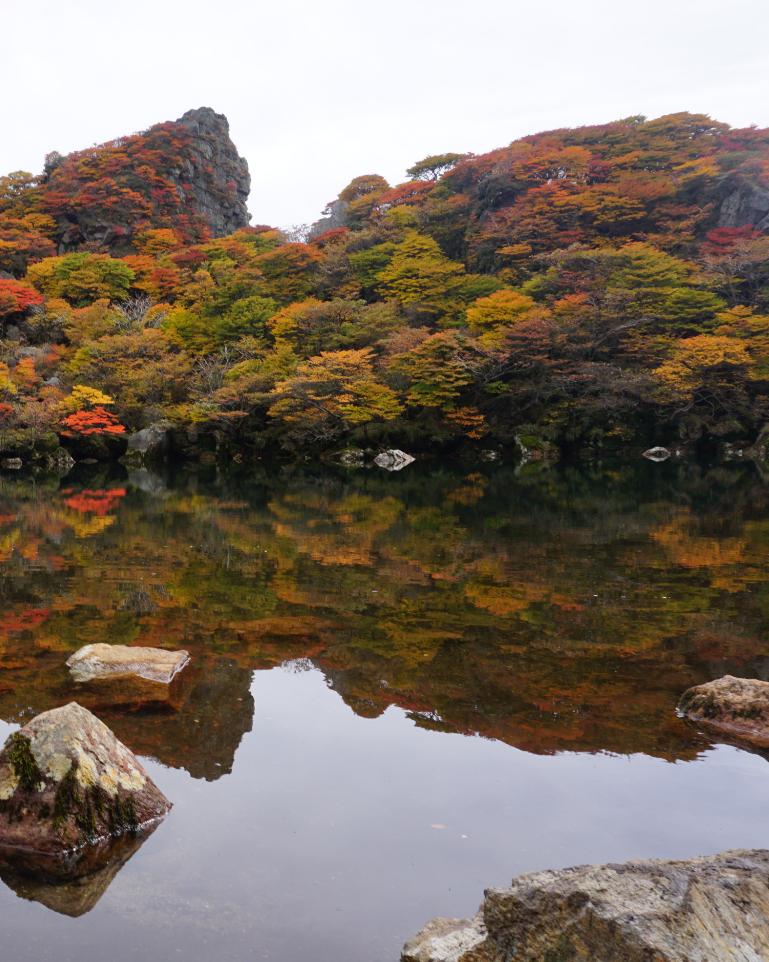
KalistaPattison
All things Halloween. This includes and is not limited to pumpkins, scary video games, and wearing a different costume every single day of October.
JonSolmundson
The YouTube algorithm is dragging me down a rabbit hole that leads to me getting way back into Lego as an adult, and only the eye-watering price of those plastic bricks is holding me back from indulgence.
ChloeGust
ASSISTANTDESIGNERS
QuinlanFletcher
JessicaBarton
Pesto the Penguin.
VaughnMcDougall
I've gotten back into the Ace Attorney series once again and the original trilogy are just as fun on the fourth playthrough as they were the first time!
WEBEDITORS
AustinFauntenot
Learning to do a kickflip on my skateboard. Gotta enjoy the cooler weather!
MarcoCian
Babylon 5, and, related to that, the 90s.
AbigayleGoldstein
Cozy coloring books and really nice markers.
ZoëVincent
The art my cat makes when she licks condensation off the windows in our apartment.
KatherineWinkleman
I love running on the treadmill after work, I’m like a hamster in a ball.
KaitlinStanton
I’ve been playing a lot of Stardew Valley! I try to line up the in-game season with the season happening in real life, emphasis on the “try.”
AidanKoch
Lately, I've been reading Slam Dunk for Japanese practice. Lots of great characters and enjoying even for a non-sports person like me.
TaylorHamada
Reading a ridiculous amount of books and, unfortunately, Minecraft.
JedidahWalcott
Decorating my space to my taste!
PRMANAGER
JennyChang
Learning more about sustainability and trying to practice conscious consumption.
KimberlyMatsuno
How to keep my little balcony garden alive. They say “If you are not killing plants, you are not really stretching yourself as a gardener.” At this rate, I’ll be a master gardener in no time!
CONTRIBUTORS
Shad Schwarck
Veronica Nielsen
Samuel Eng
Tanner Halbert
Jennifer Matsushita
Mini Zhang
Kalista Pattison
Sophie McCarthy
Alicia Goh
COVERPHOTO
Mark Christensen
ARTS EDITOR
Sophia Maas
Lately I’ve been watching a lot of Dimension 20. I can recommend it to anyone who likes tabletop role-playing games!
ARTS DESIGNER
Quinlan Fletcher
ARTS COPY EDITOR
Aidan Koch
Lately, I've been reading Slam Dunk for Japanese practice. Lots of great characters and enjoying even for a non-sports person like me.
CULTURE DESIGNER
Taylor Sanders
I’ve been obsessing with learning how to sew plushies. Just bought a book and have saved a ton of Pinterest inspirations and YouTube videos. Eventually I will make the Lawson chicken plushie!!
CULTURE COPY EDITOR
Zoë Vincent
The art my cat makes when she licks condensation off the windows in our apartment.
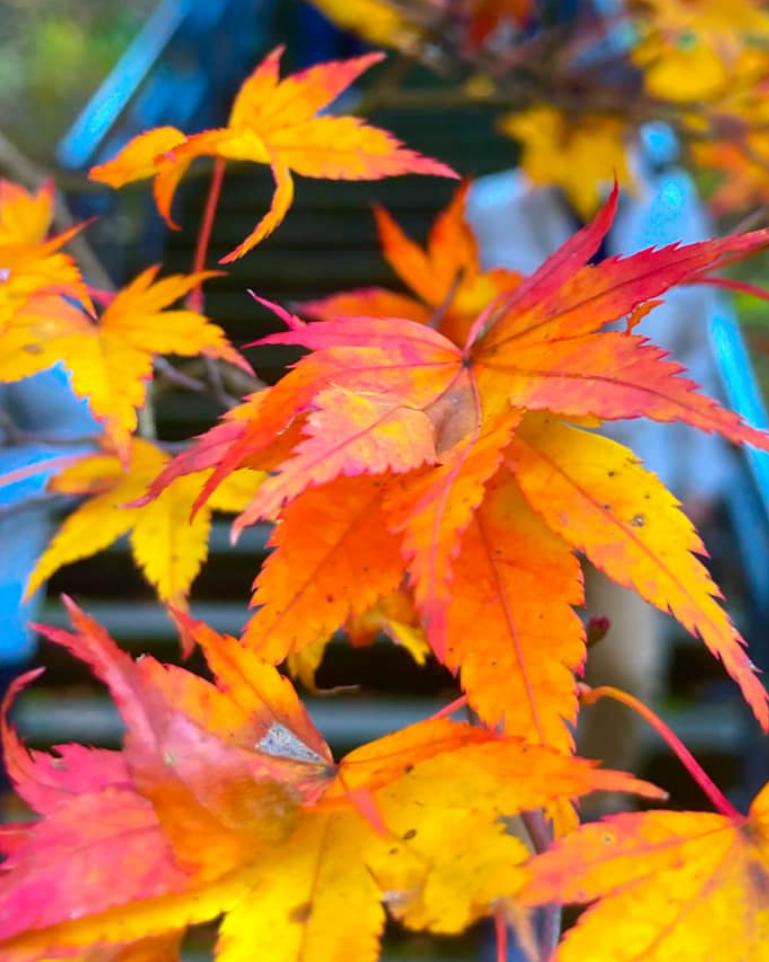
by Meg Lue for AJET
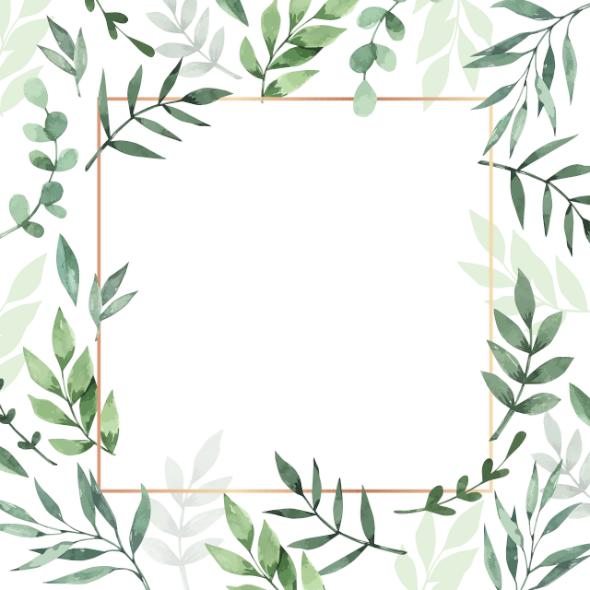
A20-minute walk from the nearest train station in Itoshima, Fukuoka, itself a 45minute train ride from the nearest major city, is a small collection of buildings meant to lodge, inspire, and host visiting artists every year. Amongst traditional Japanese houses, small mountain shrines, endless rice fields, and a beach facing the Sea of Japan is Studio Kura.
At the end of August this year, a group of artists showcased the projects they had been working on during their residence at Studio Kura. Illustrations, cyanotypes, installations, and, in one notable instance, handmade incense, were
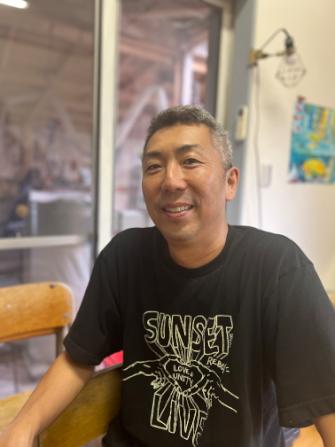
presented in various gallery spaces made out of old rice warehouses. It felt like a very welcoming and inspiring place, with each corner of the
neighborhood bursting with nature, history, and creativity. Even in the summer heat, everyone seemed very happy to be there.
I sat down with Hirofumi Matsuzaki, the director and founder of Studio Kura, and discussed the history and purpose of his residency program. He explained that, as a young artist, he had spent many years in Hanover and Berlin in Germany, meeting artists of all standings, levels of fame, and mediums of expression. At first, he was a student in Hannover, but soon moved to Berlin in the hope of expanding his horizons. His time in Berlin involved working with Kunsthaus, or art houses, and gallery spaces to host many kinds of artwork. At the time, there was an abundance of artist residency programs in Europe that Matsuzaki happily participated in

between his gallery work, but when asked by European artists if there were similar programs in Japan, he couldn’t find anything.
“I thought, in my parents’ house we have an old rice warehouse, called Kura, so it might be interesting to start my own residency programs with artists that I know,”

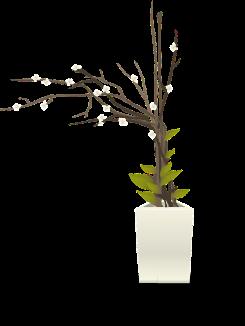

Matsuzaki said while sitting in the studio he spent many years building from the ground up. “So I made a website about Studio Kura and completely forgot about it, but a few months later someone really applied. I was shocked.”
The surprise guests, at first once a year, necessitated that he move back to Japan for month-long stints. He realized very quickly that moving between Berlin and Japan was untenable, and decided to move back to Japan for good.
“I wanted to work for a company, but no one hired me because, for ten years, I had no job experience in Japan, which is crazy for Japanese companies,” Matsuzaki explained. Instead, he worked even harder on his own company, offering art classes for the citizens of Fukuoka Prefecture. However, this posed its own challenges. “Itoshima is too far from everywhere, so no students came to learn. That's why I started to go out to kindergartens and nursery schools to see if I could teach there. They accepted me somehow and I started my job as Studio Kura. So now we have about sixty nurseries and kindergartens that we go to. And we have about ten schools in Fukuoka and Saga.”
Thanks to the art classes, he also grew his artist residency program. From one or two people every year, it slowly grew to 12 to 15 artists, usually non-Japanese, who would stay in groups for about a month. Artists are able to stay for up to
three months depending on personal preference and budget, but often the majority of artists cycle out once a month. At the end of each month, there is a gallery showing for the departing artists. Winding through the alleys of an old Japanese neighborhood, a procession of resident artists and community members listen attentively to each artist explaining their work and their time in Itoshima and Studio Kura, with Matsuzaki helpfully translating the presentations into Japanese. When asked about his motivation to
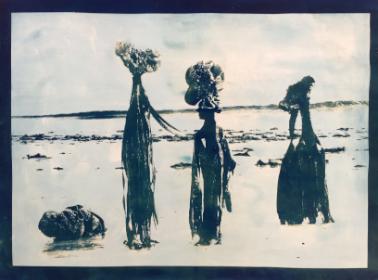
create such a program, Matsuzaki said, “When I was an artist it was very important to have the space and time to create art. So it was very difficult if you lived in your town or your home. You have a job or family and friends. It's very difficult to concentrate. So I love to join residency programs. If artists have a different input then they have a different output. So I want artists to get an interesting input here. Then they will create a different and more interesting output. Also, at the
same time we have 12–15 artists from all over the world at the same time, so they can network with people from all over the world.”
But, of course, a residency program can be set up anywhere. So why the Japanese countryside? Why Itoshima?
“The landscape in my hometown in Japan is very beautiful, but many people are leaving. The population is disappearing, which is a little sad. That's why I wanted to bring many artists from around the world, and maybe such a countryside could become beautiful and active. That is what I want to do.”
After the gallery showing, with so many unique pieces made by so many unique people, the countryside and the people in it were made even more beautiful from the experience.
Hirofumi Matsuzaki founded Studio Kura in 2007. In the following years, he has expanded his studio spaces and created a welcoming environment for artists of all kinds. You can learn more about Studio Kura here https://studiokura.info/ en/.
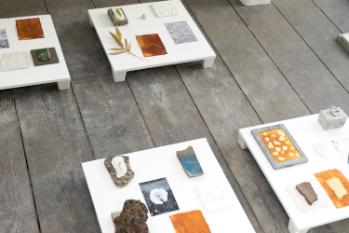
“If artists have a different input then they have a different output. So I want artists to get an interesting output here.”
Sophia Maas is an ALT in Saga Prefecture. They can be found traveling with their friends or attempting to write fiction in their spare time.






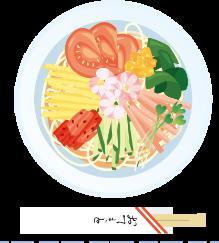










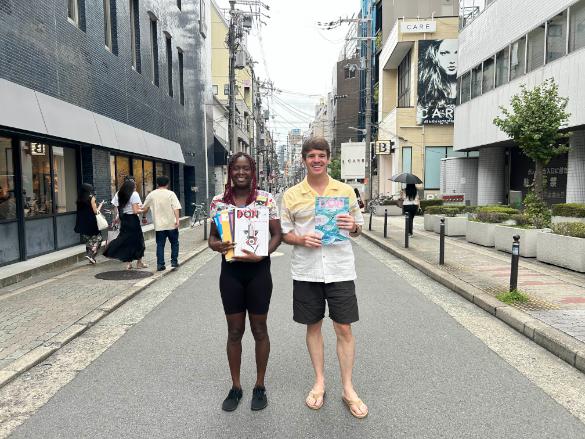



Don Magazine is an Osaka-based art magazine published quarterly, curating submitted works following a theme. Running the show are Mike Dinsmore and Ayana Wyse, two creatives bringing together a vibrant community of artists in the Kansai area.

Mike: I’m Mike Dinsmore, and I’m from California. I’ve lived in Japan for sixteen years, and I studied art history and photography. I got interested in magazines about ten years ago. Some friends invited me to contribute to a magazine similar to [Don], based in Osaka. I loved it. That magazine kinda faded away, and after a couple years I thought I’d bring it back.

Yana: My name is Ayana, but I go by Yana, ‘cause it’s easier, especially in Japanese. I’ve been here since 2011. I’m from New York, but not the city, and I studied media but I did not know what to get into. For a long time I thought I wanted to do video, so I did basically social media before it became a “thing”. Years later I came to Japan and started a group called Black Creatives Japan. I started doing photography, did that for a three-years-strong hyperfocus and that’s how I met Mike.

Mike: I had no interest in Japan or Asia whatsoever! I had graduated University and was just lazing around, traveling, and my friend was like, “I’m gonna teach English in Japan,” and I was like, “Wait, you can do that?”
Yana: We’re pretty much the same! I was in New York City, actually, in Brooklyn, for two years. I didn’t know what I wanted to do after graduating college, and I hated working in the city. I was like, “I don’t like New York! What do I do?”

And I had a friend who lived in Japan before me, and I asked her about her experience. She’s a person who likes to be with her family, and she was able to stay away from her family for six months, and I was like, if she can do it, I can do it!
Mike: I’ll start with how we started the magazine. I had an art show with some friends, and we were all winding down, having drinks, about to put things away, and we were like, “We should do a magazine?” And my friends were all photographers and were like “Ok!”
A friend has a really big photo studio, and I said, can we rent it out for a whole day? We're gonna get everyone we know to come and model and photograph. So, the first issue is really photo heavy, all the models are the same with different photographers—everyone in the same space creating, but we all have different interpretations or different styles.
I asked a bunch of friends to contribute some art, to give some variety. That’s the whole point of Don, we have this base donburi and we can do whatever we want—different



flavors, different toppings for each issue.
Yana: A variety of art. All kinds of art! Any medium, really—we’re doing things in person at the release party, we have people selling their clothing or bags, we have live painters. We also had a pole dancer! Y’know? Things that you can’t put in a magazine we also want.
Mike: Around Reflections, we started incorporating videos, and now we regularly have people submitting videos. Mixed media!

Mike: Success, for me, was to give the magazine away for free. I wanted to create a magazine, people contribute their art, I print it and give it to people for free. I don’t wanna make any money, I want to pay for everything.
Yana: Our success is just making it selfsustaining, and keeping the community willing to submit every time. One of the venues closed that we were working at, and luckily a friend at Swissotel [a hotel] talked to the manager there who’s also a foreigner, and he’s like, “We’ll pay you!” And we’re like, “Are you sure?” “Yeah! And we’ll pay for the magazine printing!” They want to make money, so if a lot of people come they make money from the bar and kitchen, and we can keep having a free event and giving out the magazine for free.
Mike: As far as goals, I really wanted to branch out, and we got a lot more design, and in this one we actually had a drag performer at the event. That was the first time we had a real performance. That really kind of changed the way I was thinking about our events.


Mike: People are contributing, a lot of people are also helping us at events, volunteering or helping organize stuff. We’re just a volunteer magazine, so people will come in waves, be part of the magazine for a while, and then kind of move on. At first I was kinda taking that a little personally. I felt like, “You’re part of the team, man! You’re leaving us!” But hey, it’s not a job, and it’s for free.
Yana: What I’ve learned too is that people will get excited for it, but only for a short time, because it’s not their own.
Mike: I contributed to another art magazine based in Osaka before Don called Kami Hikouki, same as we’re doing now, growing like this, but then some people went back to Canada, or back to America, and then… It’s sad, but people come and go. But even after it stopped, it left a legacy. And because I started with that transient feeling, I was a bit more accepting of it.

Yana: As a submission based magazine, new people enter all the time. I like variety, I don’t want it to

always be the same people. I’m always happy there are submissions from new people! And I like seeing our regulars. That’s what Don is all about—having our base and mixing different toppings. I’m ok with the transience. We’ve been here for so long. In the donburi —we’re the bowl!
Mike: We’re just gonna do this as long as it’s fun. And we always remind each other about that. If it’s not fun, we’ll go on from there. But it’s still fun, so we’re still here.
Don Magazine is open for new submissions quarterly and invites artists from all across Japan to contribute. The magazine’s summer theme, Wear and Tear, debuted on September 29th, and Swissotel Nankai Osaka’s Nambar10 Retro Bar, and the magazine’s current theme, Ritual, is accepting submissions now. Keep up to date with Don Magazine’s events, calls for submission, and collaborations by checking out their Instagram @don_ magazine or at their website donmagazine.carrd. co.
Mike Dinsmore is an English teacher with a passion for photography, athletics, and community. He runs a private photo studio in southern Osaka and enjoys experimenting with a range of photography and print techniques .
Ayana Wyse is a talented photographer, video producer, and coordinator of Black Creatives Osaka with experience in media of all kinds, from podcasts to print. She enjoys roller skating and streaming cozy games on Twitch.
Shad Schwarck is an ALT in northern Osaka who likes dabbling in design, game dev, and illustration.





Brooklyn Vander Wel (Hokkaido) now in her mid-twenties, she has much more to reflect on as she walks through the museum’s updated exhibits. Not just about Hiroshima, but also about Kyoto, the current city she lives in.
It’s been almost twenty years since Hiroshima native Kayo Takemoto last visited the Hiroshima Peace Memorial Museum. When she went, she was in elementary school. But
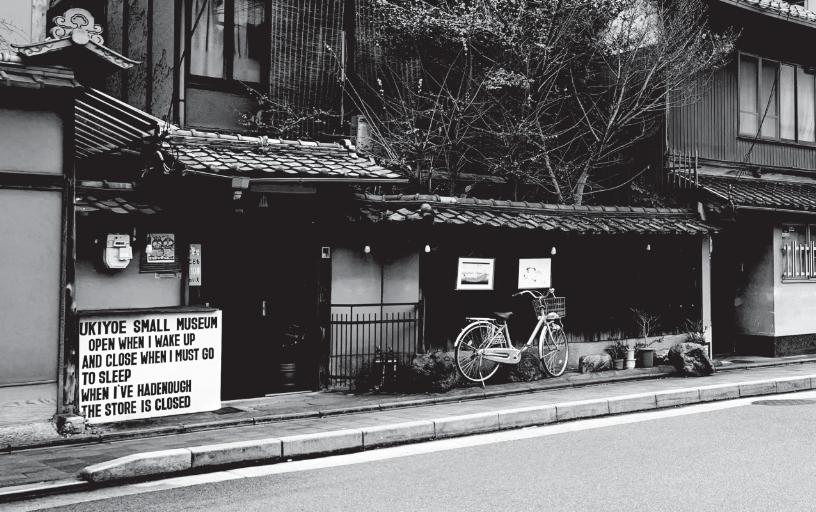
At first she’s hesitant to describe herself as an expert on Hiroshima and Kyoto. “I’m not sure if I’m qualified to talk about it,” she admits. “I’m just a local, and I may not be so sure about the culture.” But sure enough, after spending the first eighteen years of her life in Hiroshima Prefecture and then eight years in Kyoto City, she has a lot to say—and with deep affection too.
What first comes to mind when she thinks of Hiroshima is okonomiyaki, a layered pancake made out of flour batter, cabbage, savory sauces, and— unique to Hiroshima—yakisoba. Put simply, it’s Hiroshima’s soul food. It wasn’t until recently that Kayo learned exactly why it’s referenced that way.
After the events of World War II threw Hiroshima into deep levels of chaos and poverty, it became extremely popular because of its accessible and cheap ingredients
Okonomiyaki is not only a beloved dish, but a symbol of renewal in Hiroshima as well. “ ”
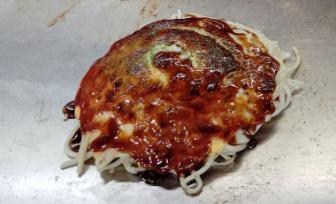

As for Kyoto, Kayo lovingly presents a familiar montage. Matcha, temples, shrines, festivals, bathhouses, cafes, and its own traditional cuisine: locally produced side dishes known as obanzai. There’s actually a set of architectural codes called keikan jourei that protect Kyoto’s traditional aesthetics and buildings. Something else that shouldn’t be overlooked are the multiple rivers which flow throughout the city. The riverbanks are popular gathering spots: whether that’s for picnics, flower viewings, or peaceful walks. Every day a mix of locals, university students, and tourists frequent these trails due to Kyoto’s reputation as not only a historical hub but a college town too.
There are even a few things Kayo didn’t realize about Hiroshima until she moved to Kyoto for university. Like how the Hiroshima accent is softer than the Kyoto one, especially in the countryside where she grew up. She wishes she could hear it more often. But it’s hard to find, especially since she hides her own local accent to blend in with urbanites from Kyoto.
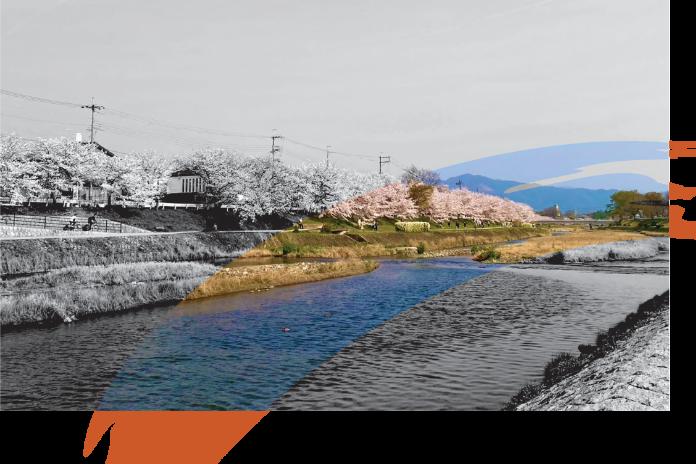

That’s another thing: Kyoto natives, who grew up in the centralwestern part of Japan called the Kansai region, can immediately recognize Kayo isn’t from there. The intonation is different in many words, like whether a syllable is pitched up or down, such as the Japanese words for October and onion. She notes that a funny difference between Hiroshima and Kyoto is that the former calls McDonald’s Maku while the latter says Makudo.
When asked about how Hiroshima and Kyoto want to grow in the next ten years, Kayo goes quiet. It’s a hard question, but ever the keen observer, she shares a few ideas. In Hiroshima, there’s talk of expanding the tram system, and someday restarting the subway project that cost too much to build. Near the main line of Hiroshima Station lies Zoom-Zoom Stadium and another goal, promoting the Hiroshima Toyo Carp baseball team. It has its sights on winning the Japan Series championship, as they are one of two teams who have not won in the 21st century.

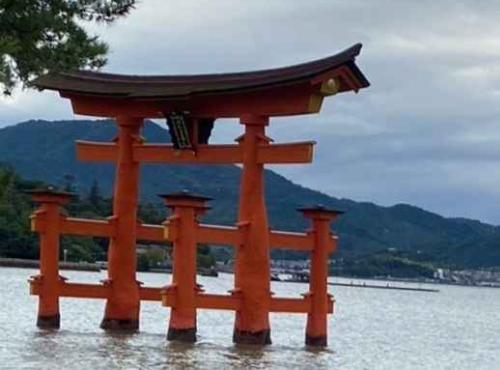
In regards to its food and drink ambitions, Hiroshima wants to improve the publicity of its sake industry. Although it has award-winning breweries and is highly respected among sake connoisseurs, the average person remains unaware of Hiroshima’s reputation. In addition to there being not that many accessible sake tasting rooms, especially in English, there’s also the fact that sake isn’t popular among young Japanese people. There’s much to be excited about, but Kayo notes that Hiroshima still has more left to do to incentivize people to move there and sustain growth.
Even Kyoto has its work cut out for it. Due to the ongoing tourism surge, the hospitality sector doesn’t have enough facilities or staff to accommodate the flood of guests. Since many places can’t afford to hire large amounts of personnel, there’s hearsay that companies are researching technology like robots and supercomputers to bridge the gap. When it comes to transportation, essential for tourists and locals alike, Kyoto hopes to expand its train loops.
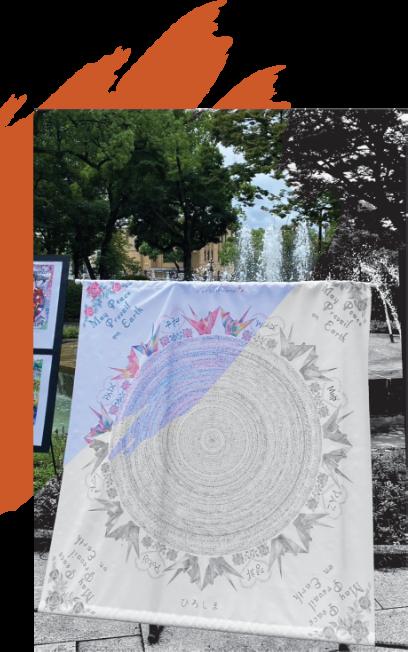
Kayo also notes that buses are routinely late by five minutes or longer, a big deal for a country that prides itself on being accurate to the minute. She predicts that other forms of transportation, like rental bikes and scooters, will become more common.
About the nightlife scene, Kayo explains it could do better. Most cafes close at 5pm or 6pm, while shopping spots fare a bit better: ending between 8pm and 9pm. But, besides some bars that stay open late, there’s not a lot to do with friends after dark. While it’s a difficult process to renovate old houses into shops and restaurants while upholding building codes, she looks forward to seeing the city expand, improve its neighborhoods, and open some night cafes.
Back in Hiroshima at the Peace Memorial Museum, Kayo mentions that, although still difficult, it’s easier now to look at the exhibits than when she was a kid. She’s learned and done a lot since then, like how she graduated university with an English degree, talked with people from all over the world, and lived alone for years. She still closely holds the value of peace that Hiroshima taught her at an early age, and continues to gain new perspectives and insights from her second home in Kyoto. Although she may prefer life in Kyoto over Hiroshima because of its more bustling nature, she confirms that she loves both places equally—along with everything that they’ve taught her.
Brooklyn Vander Wel is a first year JET participant who lives in the most northern region of Japan and spends time taking photographs on the coast and trying out as much Japanese cuisine and tea as is physically possible. They love language exchange and teaching fun phrases like “deer in the headlights” to people in their community.
Imagine hundreds of bright, colorful paper lanterns floating peacefully down the Motoyasu River before the Hiroshima Atomic Bomb Dome.
When twilight breaks, the lanterns come to life as candles illuminate them and their messages calling for world peace. This rare spectacle is the heart of the Hiroshima Lantern Ceremony.
On the evening of August 6th every year, the city of

Hiroshima hosts its lantern ceremony to honor the lives lost during the atomic bombing in 1945. According to the city’s official website, estimates suggest that around 140,000 people died in the bombing . With about 350,000 people present in the city on the day of the bombing, many died or suffered devastating injuries alongside Japanese citizens, including exchange students and immigrants from other countries in Asia, prisoners of war, and others.

ince then, Hiroshima has held the lantern ceremony each year, attracting city residents, Japanese citizens from other prefectures, and visitors from all over the globe.
From 6:00 p.m. until around 9:00 p.m., locals, students and tourists created and placed their lanterns in the river, each bearing a call for peace. This year, visitors could view countless lanterns gently drifting along the river, their collective glow reflecting the city’s powerful message of hope.
One by one, two by two, lanterns in bright colors drifted alongside one another, making it easy to appreciate their hand-drawn illustrations, like the dove of peace. Others had various symbols of Hiroshima like the Carps baseball team mascots.
Some more artistically ambitious even displayed detailed landscapes, including countryside and cityscapes. Written along their sides were short, concise messages that drove their ideas home with four kanji characters that mean “world peace”.

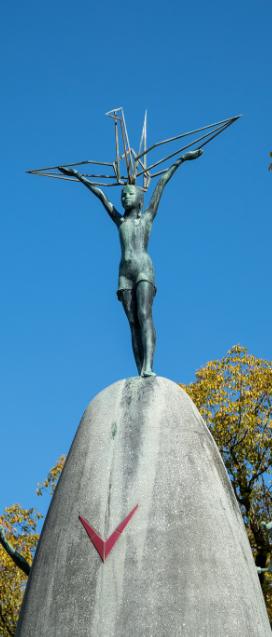
Watching the lanterns slowly drift along the Motoyasu River is a far from somber experience.
On the contrary, it seemed to provide multiple spectators peace of mind. Many people watched silently as more and more lanterns were placed in the river for others to gaze at. Which direction the lanterns flowed from and where they headed didn’t matter.

Simply watching them move down the river calmly provided a relaxing mood and assurance in knowing they continued downstream, as nothing else could capture a strong sense of peace like this. Instead of creating a gloomy atmosphere for an event surrounding the bombing, organizers took the lantern ceremony in a more positive direction by opening room for attendees to share a broader range of ideas promoting a world free from atomic warfare.
Gently bobbing up and down in the water, candles flickering steadily, the sight only grew more beautiful as the sun set. A few lanterns suffered the unfortunate fate of burning up in the water, but nothing about the event and the atmosphere put the audience on edge. As attendees and event organizers staggered placing lanterns into the water, it drew attention to the clusters of lanterns and their messages written by people from Hiroshima and all over the world.
While the in-person event leaves a far stronger impression on viewers, an online lantern ceremony took place when the in-person event got canceled for 2020 and 2021 due to the COVID-19 pandemic. People from any country could submit messages online to appear on lanterns that flowed down a digital river to preserve facets of the in-person ceremony.
The Hiroshima Lantern Ceremony fulfills its purpose by visually demonstrating the wishes of its attendees to remember the atomic bombing, as they also hope for a future without similar tragedies. Participants releasing their lanterns into the river also meaningfully encouraged more people to understand the severity of the bombing. Less than a five-minute walk from the Hiroshima Bus Center and about a 20minute train ride from Hiroshima Station, the Atomic Bomb Dome is easy to reach.
The city’s willingness to consider and implement ideas with current technology helped keep the Hiroshima Lantern Ceremony as relevant as before the pandemic began. As the coronavirus has subsided on a larger scale, the in-person event shows promising signs of continuing every year when possible.
If you happen to visit Hiroshima around the anniversary of the atomic bombing, be sure to check out this incredible ceremony and create a lantern representing your message and ideal vision for a brighter future.
Veronica Nielsen is a Coordinator for International Relations (CIR) in Hiroshima Prefecture. She has traveled to all four of Japan’s main islands, and hopes to visit all 47 prefectures one day. Her hobbies include drawing, reading, writing, traveling, and attending concerts.

ENTERTAINMENT EDITOR
Chantal Gervais
Moo Deng is life.
ENTERTAINMENT DESIGNER
Quinlan Fletcher
ENTERTAINMENT COPY EDITOR
Kaitlin Stanton
I’ve been playing a lot of Stardew Valley! I try to line up the in-game season with the season happening in real life, emphasis on the “try.”
by Chantal Gervais (tokyo)

Comiket is intense, but it is exactly what it needs to be: a place of gathering, acceptance, otherworldly passion, and unbridled celebration.
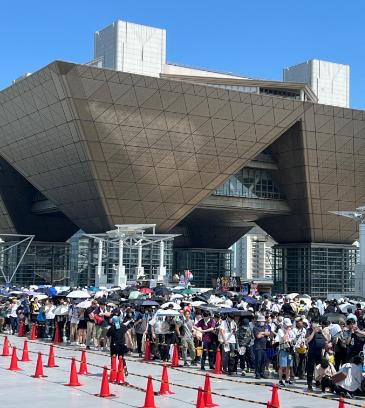
The feverish creation and consumption culture of Comic Market, or more commonly known as Comiket is jarring at times. Some attendees celebrate with such enthusiasm that before the noon sun hits, they create a parade of wheelchairs and stretchers. Medical staff part the crowds like the Red Sea and take the patrons, still clutching their purchases, to seek immediate medical attention. Guardians of the radial event are the volunteer staff shepherding in attendees while waving their hats like a guiding beacon of light. Unsung heroes hidden in the corners attentively stand watch by the vending machines, restocking at the speed of light, villages of boxes begin to build, like yatai lining the festival walkway. Instead of yukata, people come dressed in cosplay, performing for the cameras like the dancers of a bonodori.
Held twice a year, during summer and winter, Comiket creates an experience unlike those in other Japanese pop culture conventions seen around the world. Comiket is intense, but it is exactly what it needs to be: a place of gathering, acceptance, otherworldly passion, and unbridled celebration.
In the winter of 1975, Comiket saw its humble beginnings take shape as a singleday event with roughly 700 attendees and 32 “circles”. Originally dissatisfied with the related conventions of the time, a group of Meiji University students filled a void, organizing an event where independent doujinshi creators and fans could gather. The founding event was primarily composed of junior and senior high school girls. Comiket was also created in a larger sense “as a ‘space’ reserved for people to pursue new possibilities in creative expression in the realm of manga, and to act as a forum for communication between fans.”(1) As of the most recent event, Comiket 104 (which took place August 11-12, 2024), there were over 260,000 people in addition to the 24,000 circles who attended the event over two days.
The technical definition for doujinshi is “selfpublished noncommercial publication.” Breaking down the Japanese leads to a literal translation of doujin: a small group of people with shared interests and tastes, and shi: publication, leading to a friendlier translation of fan publications. These can range from comics, to music, photography, and more.
A circle is a group of people or an individual who creates doujinshi. It can also be viewed as a publisher of sorts. The famous mangaka CLAMP, known for works such as Cardcaptor Sakura, Chobits, and HolicXxx, originally began as a doujinshi circle. As of Comiket 104, circles are grouped into categories and popular series while being exhibited in specific halls on alternating days.
Veteran attendees arrive with clipboards and detailed notes on what booth their favorite artist and circles are located at and what they are selling. There is a plan of action, even down
to how the individual will move between the giant halls as they scour for their desired goods. Many people attend the event solo, on a divine mission to obtain the limited items, but it is evident that attending in small groups of friends is the preferred method. At times the halls become so cramped, a divide- and-conquer plan of action is required, forcing the groups to split up. Once they have acquired their goods, their camps are scattered through the edges of the convention center where they discuss their successes of the day. Many come prepared with hard plastic cases to transport their purchases home, while others decide to go big and buy enough that it is required to ship home in a large box. There are even people arriving to the event with luggage suited for international travel, only to fill them so full with goods that by the end of the day, they struggle to close the container.
But what has nurtured this profound experience? Comiket has built itself on a foundation of ideologies. One of these foundational pillars is the belief

that every individual attending the event is considered an equal. Whether it be general attendees, participating circles and corporations, or volunteer staff, every single person in attendance is celebrated and acknowledges that without the variety of individuals coming together, Comiket would not be an event to be celebrated with such ferocity. The celebration and energy that is created builds into a second founding pillar, which is the concept of Hare No Hi, a day of excitement, experiences, and most of all, shining intensity. These are the days people long for, that they spend countless hours preparing for. The days marked on the calendar in bright red ink.
Juxtaposing the mundane days of Ke No Hi, the ordinary days that pass by without any special markings. Comiket is more than just a special day, and instead can be viewed through a larger lens as a cultural concept that transcends the banal and celebrates a radial spirit. Comiket can be seen as part of the perpetual human activities associated with creativity, where people celebrate with one another the birth of new creative works and rejuvenate their drive to continue creating yet new material..
Comiket has garnered a polarizing reputation for a reason. Comiket not only has notoriety for how long it has been running, or even how many people attend. It does not simply have a prestige for the diversity of booths and attendees. And it is beyond the renown for the endless lines of fans snaking deep into the summer heat, waiting to collect the next doujinshi on their meticulous wish list. Comiket has a unique eminence because it has harnessed, developed, and nurtured a fanatical atmosphere. Every moment, every facet, and every breath of Comiket is intense. Comic Market 105 will be held December 29-30, 2024 at Tokyo Big Sight. This event will mark Comiket’s 50th anniversary.
1. Comic Market’s Vision
2. What is Comic Market?
Chantal is always on the lookout for the newest seasonal snacks and the weirdest gachapon she can find. Her hobbies include napping, talking about the Dune series, and accidental karaoke nights.




Insights into Writing and Japan with Kianna Shore
Chantal Gervais (Tokyo)

IIssues of Kianna Shore’s Blade Runner: Nexus .
t seemed like a scam. Kianna Shore received a message via Twitter from an unfamiliar user. She opened the message with trepidation. It asked about interest in authoring an unannounced Blade Runner comic series. Hesitant, she answered. It was no scam. The message was genuine, and after several discussions about world-building, Shore was asked to submit a writing sample. Although the opportunity came to her unexpectedly, it was built on the hard work she had already put in, marking the start of her next challenge. “I try to create worlds and stories that can only be told by me.”
Born in Busan, South Korea and adopted into a family near Dallas, Texas, Kianna Shore has been telling stories since she was young. “I would write for fun, join in online RPG’s, and dabble in some fanfiction, but it wasn’t until university where I thought writing could be a thing.” Shore attended Boston University’s School of Global Studies and received her MFA Screenwriting degree from UCLA. During her time at Boston University, Shore took a speculative script writing course. A speculative script is a script written outside a studio or production company about an established series. It is used to pitch not only an idea but also the writer’s ability to craft a story with action, structure, and dialogue. “I realized that a spec script is basically fanfiction that industry pros might actually read. It was my turning point in my life as a young writer.” With school behind her, Shore went on to work on webseries, Stage Fright and Chicken Girls as a staff writer. Her next project had her working
I try to create worlds and stories that can only be told by me.
with Riot Games on Ruined King: A League of Legends Story.
Blade Runner: Tokyo Nexus was officially launched during San Diego Comic Con in late July 2024. A few days later and on the other side of the Pacific Ocean, Shore hosted a launch event of her own at C/NE in Meguro, Tokyo.
One of the first things Shore spoke about when asked about writing for Blade Runner was the pressure and worries about stepping into such an acclaimed franchise. Almost everyone at the launch knew the Blade Runner franchise somehow. Even Shore herself remarked on how she had written papers during her Masters program on it. Shore felt deeply and wanted to do right by fans, but she also wanted to make Tokyo Nexus stand out and shine as its own creation. “A great story moves me. For me, a story can be as sharp and witty and unpredictable, but if I don’t care for the characters, it will not stay with me forever. . . “
It was here in this belief she decided that, while Blade Runner had been innovative for its era in 1982, she wanted to steer clear of the prevalent 1980s science fiction tropes that often fetishized Asian culture and reinforced misogyny. “In my story it was important to me to give such characters power and a chance to develop their own agency.” Some personal experiences Shore drew from to combat this were her identity as a Korean-
American, and living as a foreigner in Japan. “I definitely know about the foreigner experience in Japan — but also feeling like a foreigner in your home country.” The lead character, Mead, is Korean-American much like Shore herself; and her partner, Stix, is African-American. The beginning line in Tokyo Nexus reads, “The nail that sticks out gets hammered down’’. A classic Japanese idiom. This accurately describes the two lead characters and experiences Shore can relate to. After the audience is introduced to Mead, they are quickly able to put together that she follows the rules but her moral compass ultimately comes first. Leaning further into this discussion, Shore mentioned a scene that particularly stands out in the first issue of Tokyo Nexus,
“. . . Mead is walking down the streets of Tokyo and sees a man getting arrested. She contemplates the false utopia around her, wondering what lies beneath the surface. How much had to be lost in order for this version of Tokyo to be in its current state? It makes her and, hopefully, the audience wonder how much are we willing to sacrifice for peace?”
Another important topic to Shore was the concept of techno-orientalism. Specifically in North American media and science fiction, techno-orientalism is the trend of imagining Asian cultures in a hyper technological society. “I wanted to show that Japan is not living in 2050, despite what all the TikToks and reels might be saying.” Shore swings for the fences and hits right back at this idea with a kei-car chase in the second issue.
The mention of Blade Runner and cars quickly brings an old tweet to mind. Next to a picture of the infamous cyber truck, a tweet on X said that ‘Cyber trucks are what Blade Runners would have driven’. It is rare to see even a Tesla driving down Tokyo streets, let alone a mammoth cyber truck. “I wanted to find a common car in Japan that would be difficult to track. . .in my universe, everyone uses a Kei car.” Opting for the ordinary, Shore grounded the narrative in reality and
I wanted to show that Japan is not living in 2050, despite what all the TikToks and reels might be saying.
stripped away another layer to techno orientalism. Juxtaposing both Eastern and Western spheres of media, Shore wanted to bring these worlds together. “Science Fiction is supposed to be an envisioning of the future, a potential possibility. Naturally, how America views the future in its science fiction, especially from the 1980s, is vastly different than 2020’s view of the future. Even though I am an American writer, I wanted to be in conversation with and honor the current landscape in Japan.”
Nearing the end, Shore took audience questions. What was collaborating with an artist like? Shore explained that the setting, story, characters, and plot were all her creations, and because of this, she felt she needed to be more hands-on with the artist in the beginning. Writing for TV or comics? Shore said “There’s so many layers to writing. Creating something out of nothing. Forging bonds with readers. . . Even our ancestors made up stories about the stars , trying to understand the world around us. Storytelling really is so very human of us.”
The last question of the day was simple and was what everyone wanted to know. What’s next for Kianna Shore? Keeping the audience on their toes, she shared that she had recently submitted a middle-grade novel to her agent, and has been working on a script for a KoreanAmerican revenge movie. Comics, novels, movies, what can’t Shore do?
“I think the spark for me is having something to say or a theme to explore. It can be inspired by something I witness, a philosophical concept, or even just a fleeting emotion I want the audience to feel.”
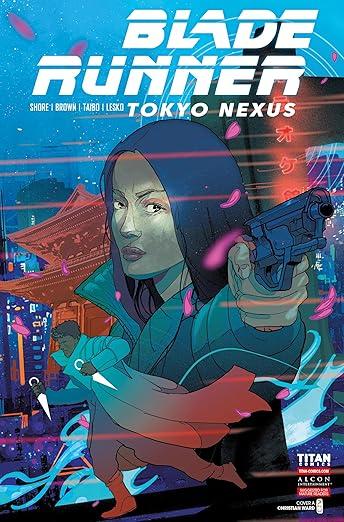
• Available to purchase print copies online at Verse
• Comics
• Available on Amazon Kindle
All photos by Chantal Gervais (Tokyo).
Chantal is always on the lookout for the newest seasonal snacks and the weirdest gachapon she can find. Her hobbies include napping, talking about the Dune series, and accidental karaoke nights.
An interview with Kianna Shore.
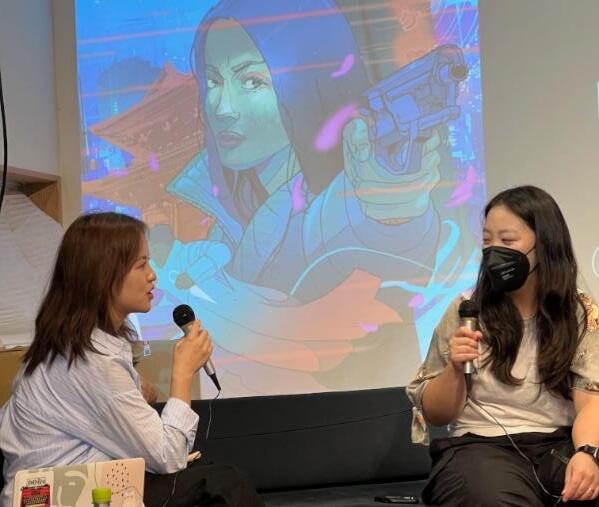
FASHION EDITOR
Sabrina Greene
I’m DEEP in Spooky Season. My blood is pumpkin spiced, and no one can find me under the 18 layers of sweaters I’m wearing. My best friend is a jack-o-lantern.
FASHION DESIGNER
Taylor Sanders
How to sew plushies. Just bought a book and have saved a ton of Pinterest inspirations and y+YouTube videos. Eventually I will make the Lawson chicken plushie!!
FASHION COPY EDITOR
Katherine Winkleman
I love running on the treadmill after work, I’m like a hamster in a ball.
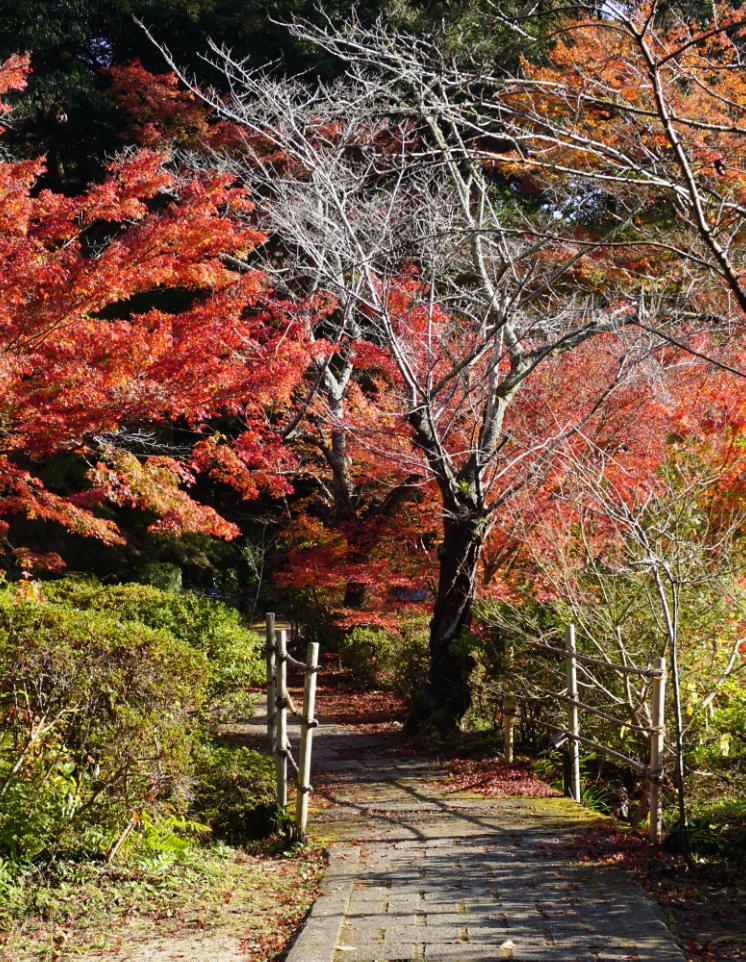
Photo by David Sanders @davidsandersjapan
WELLNESS EDITOR
Chloe Gust
I’m getting back into K-pop. A friend started showing me Stray Kids and Ateez videos, Jin and J-Hope left the army, and now I’m fully back down that rabbit hole.
WELLNESS DESIGNER
Vaughn McDougall
I've gotten back into the Ace Attorney series once again and the original trilogy are just as fun on the fourth playthrough as they were the first time!
WELLNESS COPY EDITOR
Zoë Vincent
The art my cat makes when she licks condensation off the windows in our apartment.

When it comes to Japanese fashion in Tokyo, beloved shopping districts have drawn much attention online. Harajuku has been a powerhouse for fashion since the 1980s, and remains center stage for some of Japan’s
most interesting trends and threads. In recent years, Shimokitazawa and Koenji have also become popular areas to shop, boasting many secondhand clothing stores and vintage boutiques.
However, Tokyo’s vintage scene is not confined to its streets. According to Kanda Yusuke, “Most Japanese people within the industry source their clothes from the U.S., Thailand, and the Philippines.” At least, the bigger corporations do. Kanda, the owner of Beatnik, has been running his secondhand clothing store near the Waseda train station for the past four years. Despite opening right after the height of the pandemic back in 2019 and 2020, his clothing store has been able to sustain itself well.
My supplier visits Los Angeles, mostly, and brings me back vintage pieces from the ‘80s and ‘90s. We have some authentic band tees as well, he says, “ ”
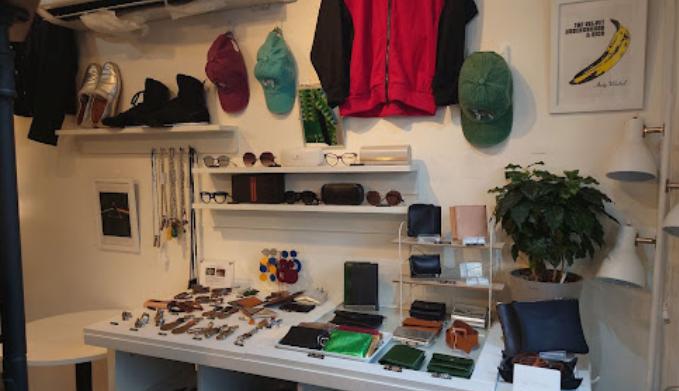
pointing to a Rolling Stones print t-shirt that hangs off the back wall. The same wall is adorned with handmade leather goods on shelves and an impressive collection of vintage and high-end eyewear. The strategy of employing a buyer and/or closing shop to go overseas to buy vintage stock for a few days is common for independently-owned stores here in Japan.

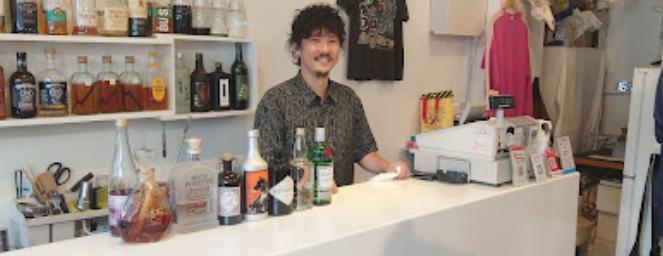
According to Kanda, running
Once his buyer returns from is incredibly time intensive. a secondhand clothing store
his online sales also make up a his goods from his physical store, While customers do regularly buy well as put them up for sale online. arrange them within his store, as conditions, put them in stock, and and maintain those with poorer piece of clothing’s integrity, fix the U.S., he must check each
good portion of his revenue.

Selling goods both online and in-store is common sense for any business owner. In Japan, an increasing number of websites and apps are being used for such sales. Big players in the market are BASE and Pay ID, with a significant number of vintage clothing stores in Shimokitazawa and Koenji using these online sale platforms to market their goods. Store owners have cited their easy-to-navigate webpage creation tools and extensive user base as the main reasons for their popularity. While the Mercari and Yahoo! Flea Market apps have dominated the market for everyday users, BASE and Pay ID have welcomed businesses. Running a physical store’s operations and having its salespeople manage the e-commerce website as part of day-to-day work has become the norm for many clothing stores here in Tokyo. The ability to take aesthetically pleasing photos of products and being knowledgeable of picture editing software are now just as prized as being a good salesperson in-store.
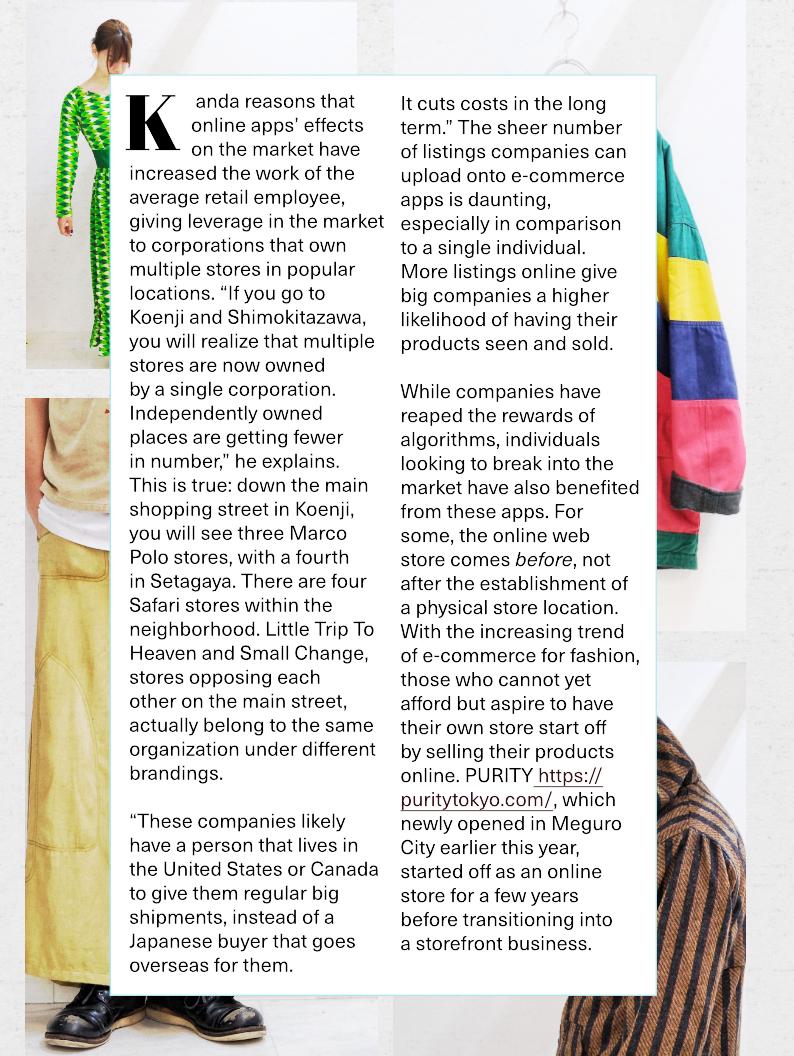
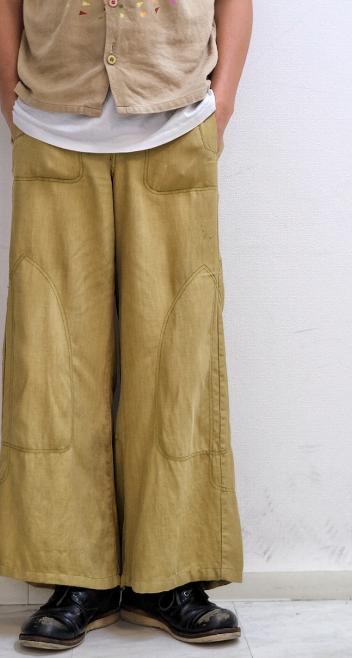
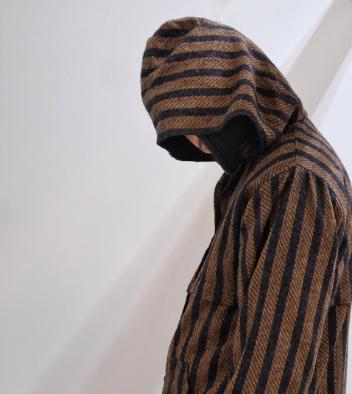

Rabble Tokyo: https:// rabble.shop/, which opened in Harajuku this year, had also long operated as online-only. While just about anyone can go on Mercari to shop for clothes from their favorite brand or search for a specific clothing item, some shoppers in Japan pay a premium for the curation that secondhand clothing shops provide. Rabble’s online site, for example, lists the approximate decade of an item’s production with detailed explanations of its make. Japanese consumers recognise this trend and are buying into it, though hardly at the detriment of stores that sell more widely appreciated stock without overt curation. According to Kanda, Beatnik primarily has older patrons who well understand American vintage already.
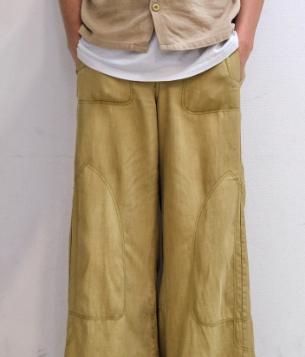
“Many of my main customers are in their 30s and 40s,” he explains. “I have some highbrand goods as well, but those take a while to sell. The day-today sales are from the quality pieces my buyer vets and sends me.” The quality of fabric, the history of the clothing label, and even the age of the zipper on a blouson can be key factors that a Japanese customer considers before making a purchase. These things can only be seen and felt in person, an experience that is limited to the brick and mortar of secondhand clothing stores.

While e-commerce platforms continue to pave the way for upand-coming fashion businesses to get a start here in Japan, they are only a supplement to brick and mortar shops for an already fashion privy community that has been shopping secondhand for decades.
Samuel has spent the last three years speaking to and getting to know local business owners around Tokyo. He is a fashion enthusiast and collector.
Kanda was born in Hokkaido and moved to Tokyo in recent years to start Beatnik. He now owns two stores in Tokyo and Shizuoka.
Beatnik01 - An assortment of vintage, handmade leather goods, and luxury items in Beatnik. Beatnik02 - Clothing Store by day, Bar by night. Kanda Yusuke. Photos from: https://beatnik. thebase.in/

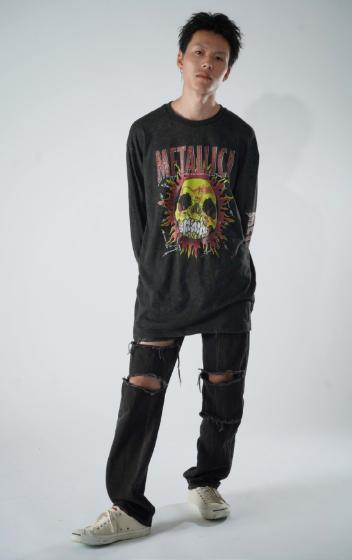
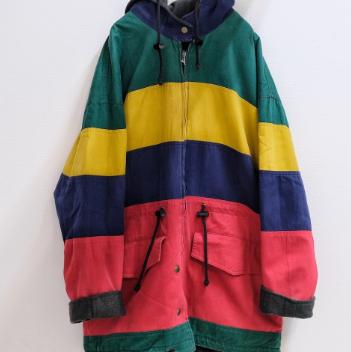
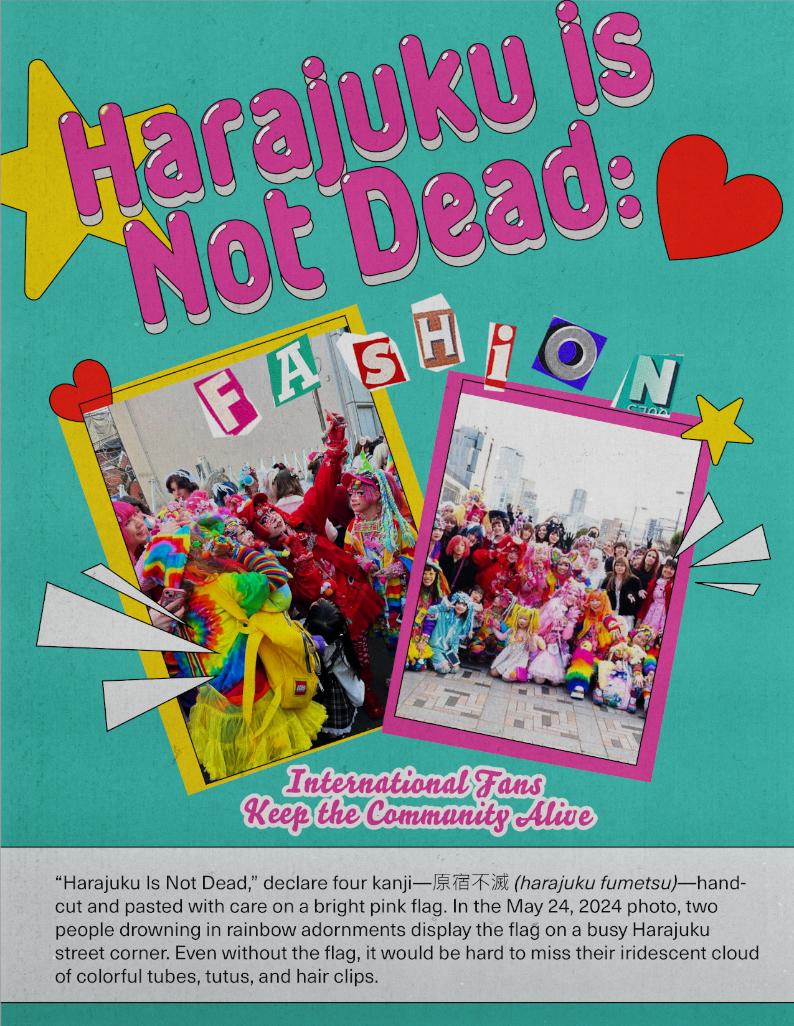





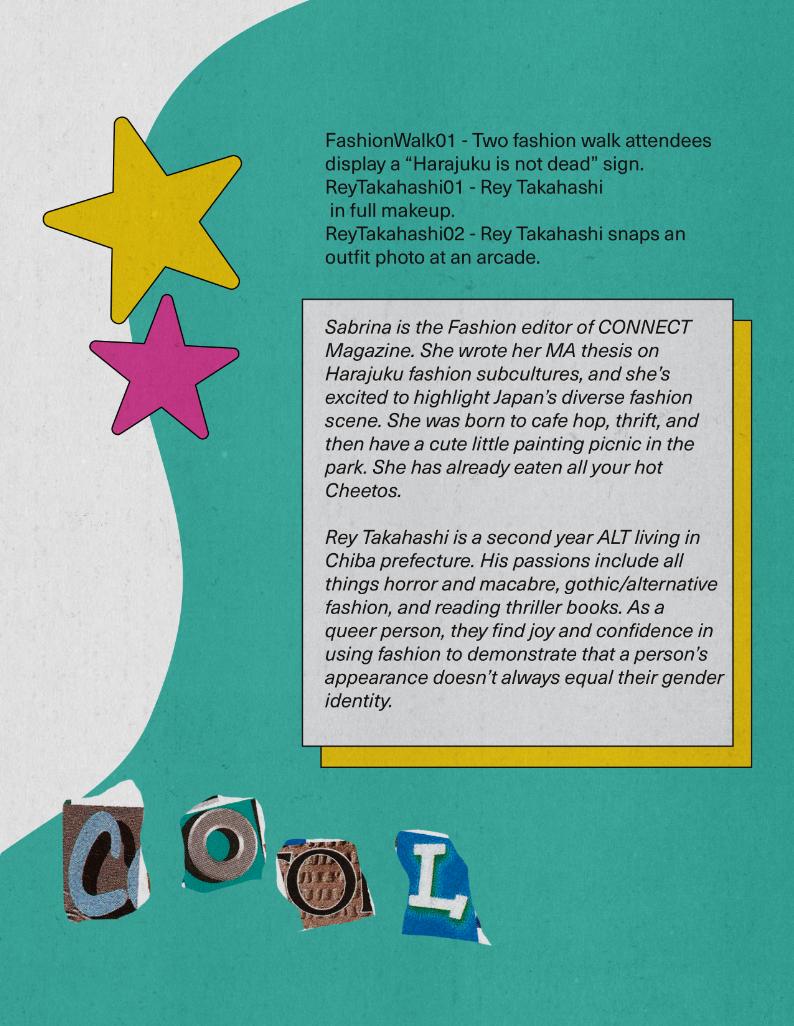
Tanner Halbert (Kochi)
Three years ago, if you told me I would run a full marathon in Japan, I wouldn’t have believed you. I started work on the JET Programme overweight and out of shape; weighing 136 kg (300 lbs). My goal entering the JET Programme was to be a good role model for my Japanese students.
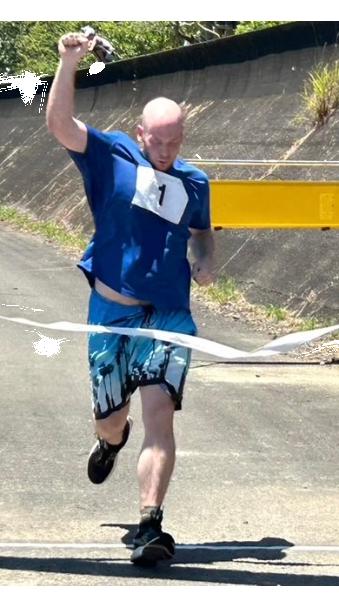
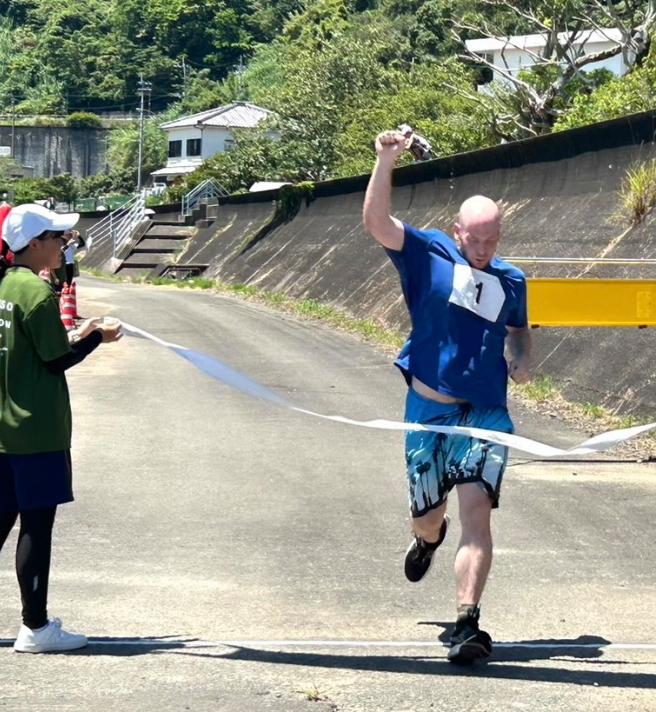
I wanted to be “The Ideal ALT: A traveler, an adventurer, healthy, fluent in a foreign language.” I wanted to be brave. However, when I arrived in Japan, I lacked those qualities. I rarely exercised, my diet was poor, I spoke little Japanese, and I was intimidated by travel.
“If I were to set a good example, I had my work cut out for me.”
In February 2022, my JET placement, Kuroshio town, hosted a 3 km run, and I joined out of curiosity. It had been many years since I had attempted any distance running, and I wanted to gauge my ability.
I jogged around my neighborhood a few afternoons to prepare for the event, but that wasn’t enough. The day of the 3 km run, I struggled. My lungs were on fire. My legs burned. I did manage to complete the event, but I needed to spend the rest of the day recovering. I was the slowest and least impressive runner. Regardless, my students saw me and cheered me on. I felt a warm glow from their encouragement. I was on the right track.
In summer of 2022, my Kuroshio friends planned to hike Mount Fuji. I took a leap of faith and decided to join them. At that point, I had done a small hike in Kochi city and the results were disastrous. It destroyed my legs and left me a sweaty mess.
Mount Fuji is known for its difficulty and even poses a challenge to experienced hikers.
To climb Mount Fuji, I needed to consistently train over the summer. I feared failing midascent and having to climb back down. It was harsh, but that fear of failure was good motivation.
I pulled myself into the final station. The next morning, we completed the ascent and were gifted with an unforgettable Fuji sunrise. It was a precious achievement. It was proof I could train my body and accomplish difficult physical feats. I could get stronger, healthier, and better.
Together with my friend Alex, I strapped on a backpack full of 1L water bottles and hiked up and down the eight flights of a local tsunami evacuation tower in the summer heat.
This unorthodox training turned us into local legends in the community. Most importantly, combined with alterations to my diet, the training worked to get me ready.

Cue the Rocky music.
I kept what I learned at Mount Fuji in mind, and my discipline continued to develop in early 2023. I started running up the tsunami tower almost every morning before work. Since I was overweight, I saw results quickly .
After the first month of running and meal prepping, my Japanese co-workers noticed I was slimming down. After three months, comments about my weight loss came from everyone, and it was often the first thing people would say to me.
Within six months, I was thinner and stronger. Acquaintances mistook me for a new person. 50 kg (110 lbs) down, my parents didn’t recognize me at the airport when I returned to visit Canada, but they supported my training efforts.
I graduated from the tsunami tower and began distance running, slowly building up my kilometers.
First, I could run 4 km, then 8 km, then 10 km, and eventually I completed a half marathon. In October 2023, I set my sights on the 2024 Kochi Ryoma Marathon and kept running.
February 18th, 2024, the day of the marathon. I was nearly half the weight, but twice the man. It was hard, but I had trained appropriately and was prepared for the mental and physical difficulty. After running an intense five and a half hours with my friend Timonique, we crossed the finish line together, finishing our first marathon.
I arrived in Japan wanting to be the perfect ALT, but my students will never have a perfect ALT.
They have something better.
They have an ALT who improved and continues to improve in small ways every day, and that’s something they, and everyone, can do too.
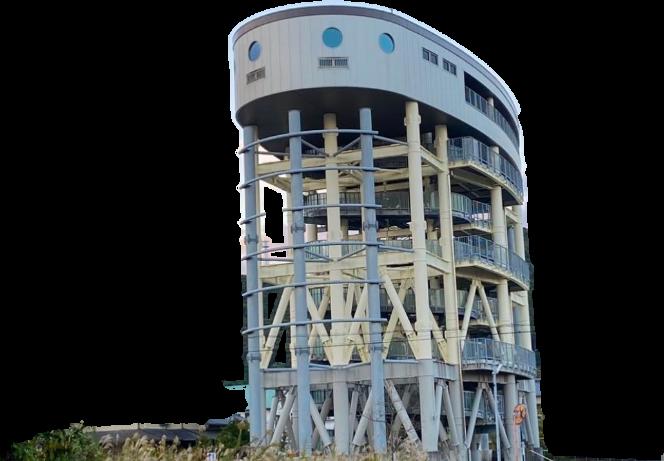

EARN YOURMASTER’S WITH A GUARANTEED$24K+ SCHOLARSHIP Turn yourJET experience into afulfilling career.
JET alumni andparticipants areguaranteeda50percent ($24K+) annualscholarshiptoward anin-personmaster’s degreeattheMiddlebury Institute of International Studies, agraduateschoolof Middlebury College.
If youareinterestedin studyingonline,youcanstill waive theapplicationfeeandbenefitfrom thelowertuition cost ofouronline programs.
DEGREEOPTIONS
• International Education Management
• TeachingEnglishto Speakersof Other Languages(TESOL)
• EnvironmentalPolicyand Management
• International Policyand Development
• Translationand Interpretation
• Translationand Localization Management and more go.miis.edu/JET
Jennifer Matsushita (Hiroshima)
Ihave always avoided fish at the supermarket. Growing up, my family never served fish unless it was frozen. My fish experience was zero when I got here.
I wasn’t confident enough in my culinary skills to wing it with fish, I couldn’t shake the thought that I’d mess it up, and, honestly, the dishes would never come out looking like the picture.
To combat my nerves, I found the one dish that isn’t about looking pretty, technical skills, or doing a billion steps. I started my Japanese food journey with namero, a minced fish dish.
The origins of namero are unclear. Aomori, Chiba, and Hokkaido have all laid claim. What we do know is that it is a fisherman’s dish.






On a constantly rocking boat with little space to prepare anything, namero was perfect.
That simplicity is what made the dish appealing to me as well.
• Fish of choice (mackerel is most common, any sushigrade fish is good), 2 fillets
• Shiso, 2 leaves
• Green onion, ⅓ stalk
• Ginger, minced, to taste
• Garlic, minced, to taste
• Miso Paste, ½ tbsp
Note: This recipe has measurements for convenience, but please feel free to change, add, or leave out toppings to your taste.
1. Prepare your toppings and create your mise en place. Chop the shiso leaves, mince ginger and garlic, and slice the green onions.
2. Finely chop your fish. This may take a while. You’ll know it’s ready when it’s paste-like and starts to stick to your cutting board.
3. Add the shiso, green onion, ginger, garlic, and miso, folding it into the fish. Start small and add in a little at a time. It’s easier to add flavor than to take it away!
4. Serve over rice or use one of the variations below.
The beauty of this dish is in how simple it is. You can’t go wrong with the basics and it begs to be experimented with. Go forth and make some namero!
• In Aomori, they serve namero with cucumber slices.
• Add natto and raw egg yolk for otsumami, or a drinking snack.
• Use as a filling for a sushi roll.
• Pan fry the fish mixture in a patty to make sanga-yaki, a specialty in Chiba.
• Mix with rice and green tea to make son-cha.
• Add rice vinegar to make su-namero.

Jennifer Matsushita is a former ALT from Hiroshima. After finding the TV show Kodoku no Gurume, or Solitary Gourmet, she discovered the joys of simple, underappreciated Japanese cooking.
LANGUAGE EDITOR
Kalista Pattison
In true October fashion, I have been obsessing over all things Halloween. This includes and is not limited to pumpkins, scary video games, and wearing a different costume every single day of October.
LANGUAGE DESIGNER
Jessica Barton
Pesto the Penguin.
LANGUAGE COPY EDITOR
Aidan Koch
Lately, I've been reading Slam Dunk for Japanese practice. Lots of great characters and enjoying even for a non-sports person like me.
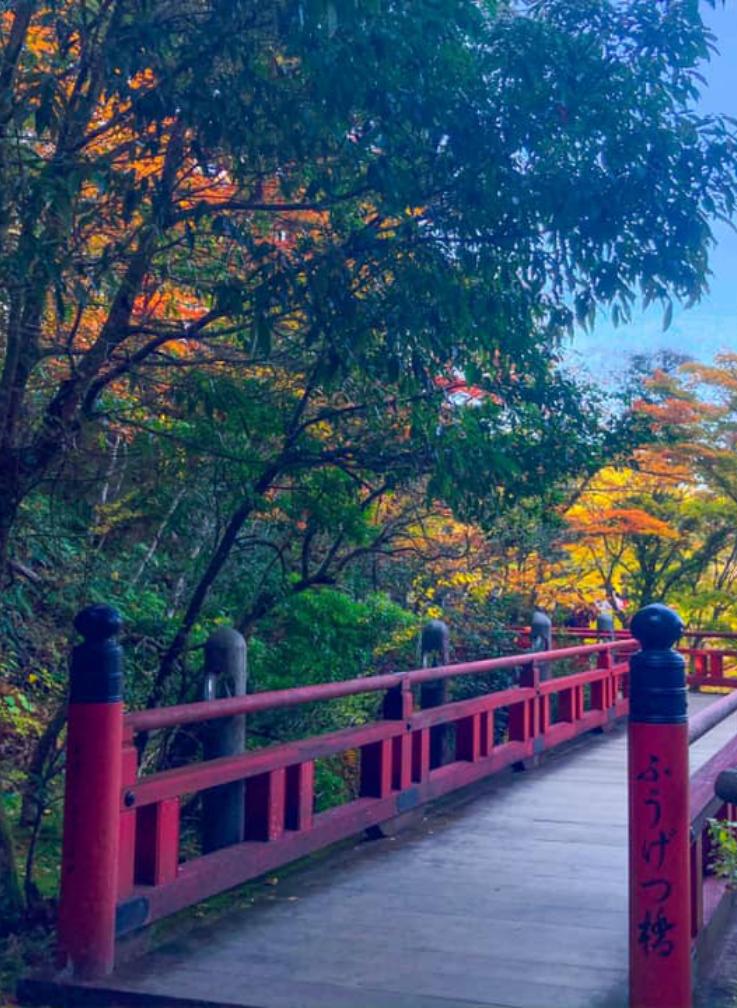
CAREERS EDITOR
Kimberly Matsuno
How to keep my little balcony garden alive. They say “If you are not killing plants, you are not really stretching yourself as a gardener.” At this rate, I’ll be a master gardener in no time!
CAREERS DESIGNER
Taylor Sanders
Learning how to sew plushies. Just bought a book and have saved a ton of Pinterest inspirations and YouTube videos. Eventually I will make the Lawson chicken plushie!!
CAREERS COPY EDITOR
Katherine Winkleman
I love running on the treadmill after work, I’m like a hamster in a ball.
Mini Zhang (Kagoshima)
A year ago I learned about ‘good nori.’
I was eating lunch with one of my students and we were chatting about first impressions. I told her that I found the students at her school to be very energetic. In turn, she told me that I had ‘good nori.’
It wouldn’t be wrong to be confused with this term, you might think that nori refers to the seaweed often found in Japanese cuisine, at least I did! That night I went home and did some digging and ended up discovering that good nori—or nori ga ii—refers to a person’s willingness to say “I’m up for it.” In the general sense, a person with good nori is open-minded and proactive. I wondered, “How did I come to have that impression?” What does it really mean to have good nori?
The months leading up to my arrival in Japan were fraught with anxiety. Moving to a new country can cause stress and a multitude of other feelings that come naturally with major change and loss of familiarity. Although grateful to be chosen as an ALT in Hioki City, Kagoshima, I had many worries. Many ALTs experience the same thing. Some of us have never lived alone before, others have never even traveled abroad. We might be intimidated by the language barrier or the lack of experience to be someone that students can learn from. This was definitely how I felt in the beginning, and at that time, I surely wasn’t someone who had good nori. Ever since arriving in Kagoshima, however, it has been surprising to see how naturally those worries dispelled over time.
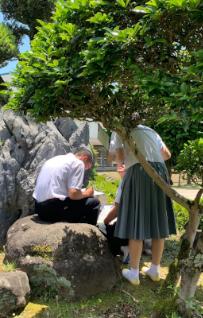
I felt my anxiety melting away the more I interacted with my new colleagues. They have always made efforts to include me in conversations and experiences, whether it be explaining cultural nuances, recommending foods to try and sights to see, or even just having a laugh together despite their busy schedules. The sincerity in the way they welcomed me was a great source of encouragement for me as someone new to not only the area, but the country itself. The confidence I gained from their kindness kept me motivated to challenge a variety of new
experiences, but most importantly this feeling allowed me to feel confident in reaching out and connecting with the community around me.
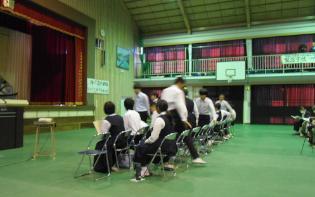
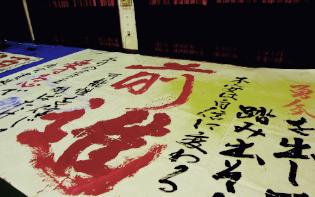
One of the most rewarding connections has been with the students. Their infectious energy and eagerness to have fun make every day exciting and filled with laughter. Yet, it was not always easy being open to their enthusiasm. There were times when I held back from conversations or questions due to worrying about how they would perceive me or because I felt unable to convey my words properly. But with experience and time, it became apparent that moments of ease created the best conversations and strengthened my bonds with those around me. Even if mistakes were made along the way, by openly accepting those moments and taking them in stride, it was possible to overcome my concerns about how I was being perceived and welcome others’ enthusiasm with open arms. As a result, I have been able to form bonds with my students that I cherish deeply. These have become a major factor in me feeling accepted by my community. This sense of belonging has been integral to the overall enjoyment of my time in Japan and has contributed greatly to the improvement of my quality of life as a newcomer to the country.

It is easy to be apprehensive when you find yourself in a new environment with new people and new social structures. Living in a rural town with just over five thousand residents and minimal public transport made it much less convenient to maintain social circles, but by opening myself up to the things already around me, my apprehension and isolation became gratitude that began to influence even the most mundane surroundings. Accepting fortuity has given me many great memories and engaging conversations I never would have had otherwise.
At the start of this journey, I never imagined myself going on solo trips across Kyushu, or striking up conversations with strangers in restaurants, shops, shrines, and temples. Approaching each interaction with open-mindedness, I can access a much-needed sense of belonging, which has allowed me to strive further as an educator and member of my community.
So, what does it mean to have good nori? As a slang term, it can mean many things. Its ambiguity—much like the often-ambiguous nature of ALT life—means that it is what you make of it. From my experience, it’s not something that you attain miraculously when you move to a new country, but rather is the result of allowing yourself to be positively influenced by your new environment.
“To have good nori is to be able to accept circumstances with gratitude and pay forward each moment with sincerity.”
Even if these moments seem insignificant, such as filling out paperwork, fumbling through ordering at a restaurant, or even getting lost in unknown places, there is always fun to be had if you are open to recognizing and receiving it. I believe that in doing so, you open an avenue into a more fulfilling life that applies
The beauty of good nori doesn’t end with just having it but rather lies in giving it away. It should be shared with those around you. This can come in many different shapes and forms. In the ALT experience, it can be giving omiyage, thinking up fun lesson plans, joining in on extracurricular activities, taking the initiative to help out, or even just starting a conversation. However, no matter what it looks like, if it is done with the intention of gratitude it will be reciprocated in one way or another. Ultimately, good nori is one’s reciprocation of appreciation. If you approach any situation with this mindset, not only will you come out with more fulfillment but it will only be a matter of time until those around you will tell you “nori ga ii desu ne!”

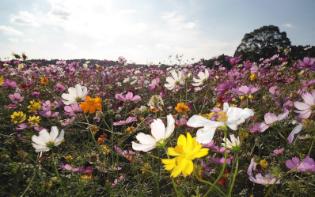
Mini is a second-year ALT from Canada currently based in Hioki City, Kagoshima. During her free time, she enjoys looking for secondhand treasures, going to the beach, and discovering the beauties of rural Japan.
Compiled by Kalista Pattison (Oita)
It’s that time of year! The Japan Exchange and Teaching (JET) Program applications are open and people from all around the world are applying for the chance to move abroad and teach English. From the outside looking in, JET is a pretty impressive program. As of July 2024, applicants from 28 different countries have been selected to move to Japan and become Assistant Language Teachers (ALTs). Not only do people from all over the world get to participate, but this program boosts the diversity of its applicants by inviting people from teaching and non-teaching backgrounds.
This is all great stuff, but from the inside looking out I’ve found some disconnect between the expectations and realities of actually working in the classroom. People very familiar with the program will know the phrase “every situation is different” or ESID, and that is very much the case here. However, there are still some shared experiences amongst ALTs that can shed some light on what it’s like to be in our shoes.
For David Diaz Aguirre (ES/JHS, Kumamoto) his job meant freedom. He says “I thought there would be a little more structure, but I had very little supervision or oversight in the Elementary Schools (ES). Planning the lessons and pacing the classes over the course of the school year so that we finished the textbook by the end was left entirely up to me.” David was an ES ALT though, which is surprising because this feeling of freedom seems more prevalent for Senior High School (SHS) ALTs. Stella Sterling (SHS, Oita) says, “My expectation was to be an assistant! To my surprise I am fully in charge of all my classes. The first year sucked but then I figured out what works and what doesn’t.”
So what exactly are these SHS ALTs doing when they’re leading the class?
Michael Gayle (SHS, Oita) also gets to be fully in charge, but he surprisingly doesn’t spend it following the textbook or teaching grammar like he thought he would. Other SHS ALTs I’ve talked to mention these opportunities to lead the classroom but usually it’s anything but a lecture. Instead, these higher-level classes focus on gamifying English and getting the students talking and creating. Some SHS ALTs are explicitly told not to follow any sort of textbook. In these cases, the ALTs are mostly brought in to have fun with the students.
David was just one example of what it’s like to be an ES ALT. It seems more common for ES and JHS ALTs to spend a bit more time in the shadows of their Japanese Teacher of English (JTE). Sean Gardiner (ES/JHS, Osaka) says “I had expected to have a much more hands-on approach in the classes. However, in my experience so far, the JTE has handled the majority of lesson planning.”
Given how many ALTs don’t actually have much teaching experience, sitting back and letting the JTE lead isn’t a big deal. That is . . . for the first year or so. After that, it’s easy to get restless or even bored during class. Jemima Lewis (ES/JHS, Shizuoka)is on the right track when she says “I should be available for students when they need individual help during class.” Maybe next time you find yourself twiddling your thumbs in class, why not walk around and check in with students who might need more help!
If you somehow find your way out from the shadow of your JTE, you might just be stepping into the shadow of your textbook instead. Cristen Braun (ES/JHS, Oita) says “I was expecting more of an effort in elementary education, as I find the books and approaches, especially in third and fourth grade, to be frustratingly ineffectual. The books themselves literally say that students should not learn how to write the alphabet in third and fourth grade. I’ve basically had to learn to pick my battles as many teachers are too concerned with sticking to the status quo than letting me practice things like phonics in third grade.” It isn’t immediately obvious to many new ALTs, but the way English is taught in Japan leaves many things to be desired. The chains imposed by the textbook can become frustrating to some who have too much time on their hands and no way to implement their ideas.
Prior teaching experience isn’t required to become an ALT in Japan and many ALTs learn how to teach through trial and error, but there are some that come in with a background in education.
Noah Langley (ES/JHS, Oita) is someone with an extensive background in both English and secondary education. He says, “While I’ve taught ESL learners before, I am by no means a certified TEFL educator and many of my established lesson plans and strategies aren’t applicable to this environment—they rely on too many given assumptions and preconceptions about the students’ reading and writing levels.”
Noah also mentions feeling odd giving up control of the classroom to his JTEs.
ALTs without backgrounds in teaching are asked to lead and ALTs with backgrounds in teaching are asked to assist. What’s up with that? It’s a big part of the aforementioned ESID and you just have to get lucky to be put in a position that utilizes you the best. That, or you speak up to push for more responsibilities or to set boundaries.
Some ALTs who come into the program with a background in education may find the teaching methods to be less than ideal as they ride heavily on things like the High School entrance exams. Lagurenh Janse Van Rensburg (ES/JHS, Oita) says “I knew and was told that the language teaching style was very much ‘learn by translation’ based, but I didn’t expect it to be so much. The amount of textbook drills that there are really surprised me . . . I come from a standpoint where I believe that’s not how you properly learn a language.”
Even if you had zero preconceptions about the job, I hope you can come to Japan and create a classroom environment that is both comfortable and challenging for you. It’s hard to know what to expect when the program is so heavily defined by ESID but that’s a part of what makes it exciting!
Kalista is a third-year JET in Oita Prefecture. She is currently trying to romance every character in Stardew Valley and can be found in an onsen or hunched over a pottery wheel in her free time.

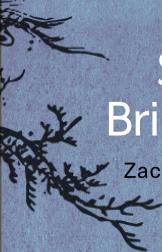
Zack Davisson (Nara/Osaka, 2001-2006) interviewed by Kimberly Matsuno (Niigata, 2019-2022)
Zack Davisson has always been interested in folktales and all manner of spooky things. Maybe it was due to growing up in the United States’ Pacific Northwest reading about Bigfoot, or the time he spent in Scotland, where he became obsessed with local fairy tales and the Loch Ness Monster.
But it was Zack’s time in Japan as an Assistant Language Teacher on the JET Program that solidified his love of Japanese monsters yokai and ghosts yurei and set him on the path to become the prolific writer he is today.
This interview goes over Zack’s entry into his career as an author, the lessons he learned along the way, and his insights and advice for young authors looking to publish their first book.
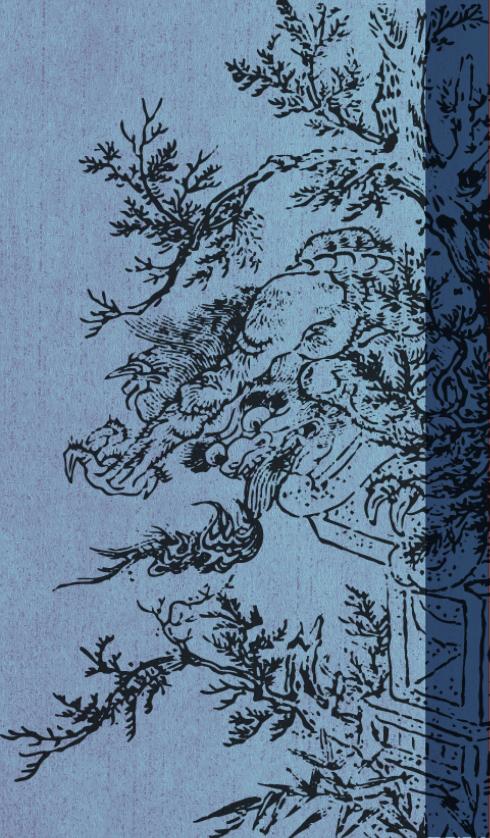

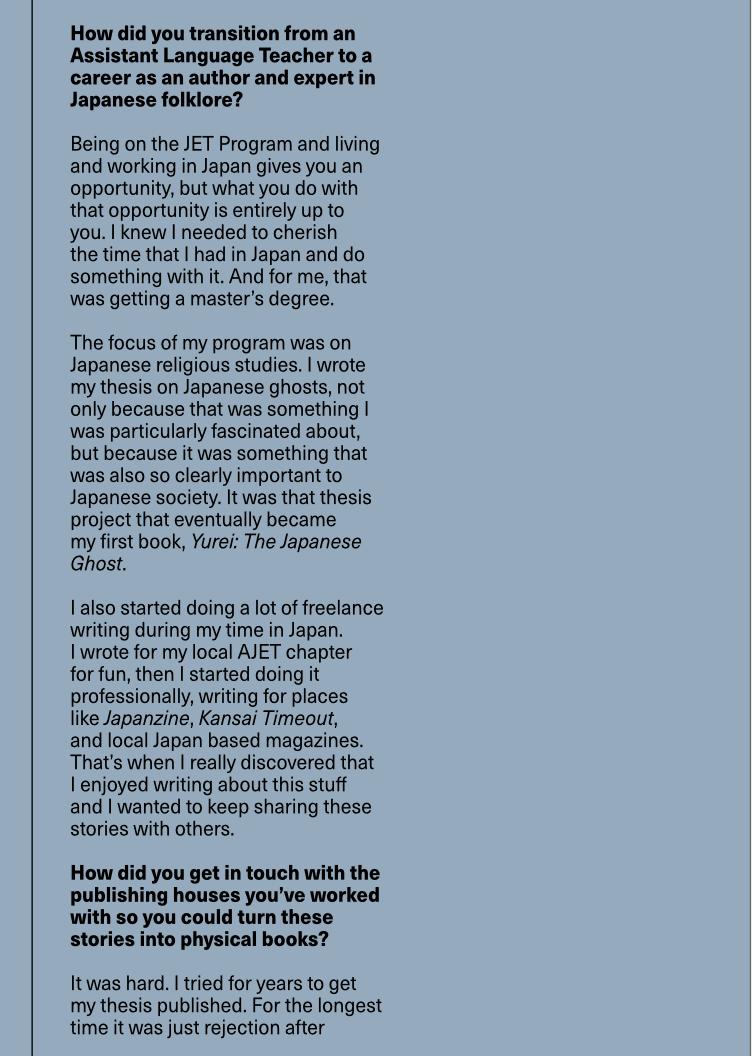
rejection after rejection. Actually, I can’t even say “rejection,” because most of the time I would send it to a publisher and then would just get zero response back.
But I eventually got a response from Gregory Starr at Kodansha. His response was also a rejection, but it came with a word of advice. He basically told me, “I like the book, but I don’t know who you are. And because I don’t know who you are, I can’t sell you.”
He explained to me that it’s hard to sell a nonfiction book by someone who is not an established expert. He advised me to start a blog or to do something to establish an identity for myself as an expert on this subject.
So that’s what I did. I started a website and began introducing myself as “an acclaimed expert in Japanese folklore,” and eventually I was able to get a publishing deal with Chin Music Press.
To write a book is one thing, but to make a book is an entirely different process. You have to figure out layout and design and all these other aspects of it that I never expected. For example, I wanted one of those cool sewn-in bookmarks. And my publisher was like, “Awesome. Those will cost you $10,000. Are you willing to lose $10,000 of royalties to get sewn-in bookmarks?”
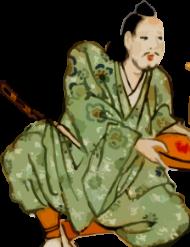

. . . So sorry, my books do not have cool sewn-in bookmarks.
Needless to say, there was certainly a bit of a learning curve where I had to learn that passion and marketability have to go along with each other. Publishing is a lot of learning how to make compromises and figuring out how to change whatever it is that you have into a marketable product.
As a writer, you have to learn to trust the expertise of the publisher you’re partnering with. It’s a tough thing to do because you’ve spent all this effort making your book, and now you have to let go. However, at the end of the day, if your book doesn’t sell, then it doesn’t matter.
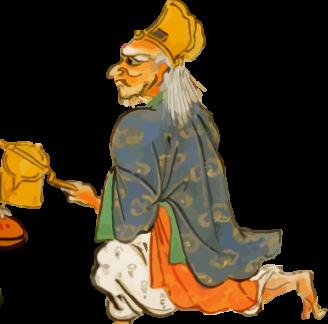
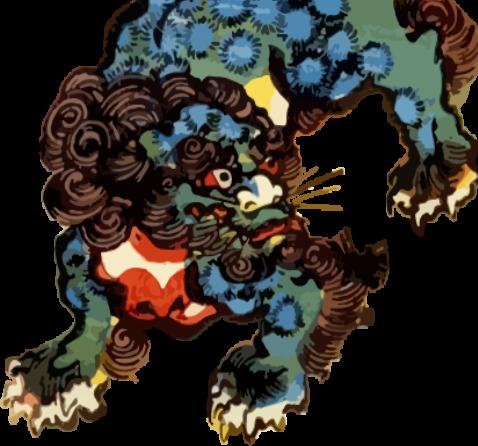
Do you have any tips or recommendations when it comes to the actual mechanics of writing a nonfiction book—from managing research to crafting a writing style or voice?
Because of my specific topic, there’s a Japanese government database called the Kai Densho database, which is basically a collection of all their folklore resources. I also rely heavily on JSTOR, which is an online repository of academic articles. Without either of those two resources, I absolutely could not do what I do.

comes to writing, my process is to not use anything other than Word. When I’m researching, I throw all of my thoughts into a Word doc. Then I’m left with a document that’s just basically filled with fragments. So I’ll open a new doc, move some of those fragments around until they make sense, and just write and rewrite and rewrite until I feel like it’s okayish.
A lot of writing style is just intuitive, but I’ve learned a lot about pacing over the years. When it comes to nonfiction, you want to give readers something that is unfamiliar, familiar, and unfamiliar again—in that order.
feel like they can understand and with something familiar, so they But then you want to provide them something to learn from you. don’t, and they feel like they have realize you know something they unfamiliar, because that way they You want to give them something
relate to what you are saying—
turning the page from one to the other. book, you are able to keep readers familiar sandwich throughout the By repeating this unfamiliar, in what you have to say. keep them excited and interested them with the unfamiliar again to you’ll lose them. Then you hit because if it’s just all unfamiliar,
Do you have any words of advice for people who are looking to pursue a career as a nonfiction writer? My favorite quote about having a career as a writer comes from the movie Rocky Balboa.“
I think it is important for young writers to understand that this career involves a lot of rejection and harsh criticism. It’ll take 200 “nos” to get to that “yes.” There are people out there that are just magically lucky, but you are probably not one of them.
But the main advice I always give to young writers is to “find your swim lane.” When it comes to nonfiction, so much has already been covered, but certainly not everything.
“It’s not about how hard you can hit. It’s about how hard you can get hit and keep moving forward.”
Find something that truly interests you, something that you could just dive down and enjoy researching. Then, whatever your swim lane is, own it. Become the person that anytime anyone thinks about that subject, they think about you. Part of that might also involve building an interest for something that doesn’t even have a following yet. I had to do that for yokai, and I still do it by going to anime conventions and giving panels on Japanese folklore and monsters.




Final question. What is your favorite Yokai?
My all-time favorite is probably kappa, but I also love this one called “eyeball butt” or “shirime” in Japanese. One of the things I love so much about shirime is that the monster is entirely just a crass joke made by the artist Yosa Busan in the Edo period. Busan’s work is all just gags. l There’s no story there. There’s no explanation. He literally drew them to make people have a chuckle, and now shirime has appeared in a Ghibli film. I just love that.
Zack Davisson is an award-winning translator, writer, and folklorist. He became fascinated with Japanese language and culture at a young age, but never had the chance to study the language or visit Japan until he was 33, when he gave up his life as a project manager at Amazon and moved to Japan on the JET Program. He firmly believes that becoming a JET was the most impactful decision he ever made, and it changed his life 100%.


His works include Yurei: the Japanese Ghost, Yokai Stories, Narrow Road, Amabie: Past and Present, Kaibyo: The Supernatural Cats of Japan, and English translations of Shigeru Mizuki’s multiple Eisner Award-winning Showa: a History of Japan, Tono Monogatari, and famous folklore comic Kitaro. He currently writes Ultimate X-Men for Marvel Comics.
He has lectured on manga, folklore, and translation at Duke University, Annapolis Naval Academy, and UCLA. He currently lives in Seattle, WA with his wife Miyuki, dog Mochi, cat Shere Khan, and several ghosts.
Kimberly Matsuno was an ALT in Niigata from 2019-2022, during which time she contributed to CONNECT Magazine as both a writer and a section editor. She is excited to continue contributing to CONNECT and to assist in fostering relations between current JETs and the JET alumni community.
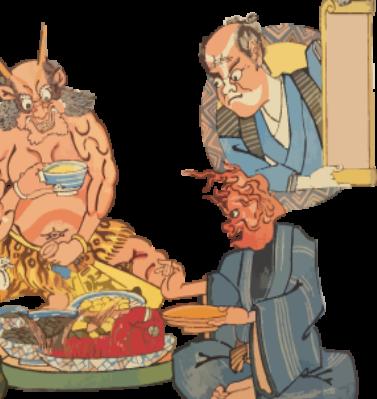


The Career Section was created through a partnership between CONNECT and USJETAA.
The United States Japan Exchange & Teaching Program Alumni Association (USJETAA) is a 501 (c)(3) nonprofit organization that furthers US-Japan understanding through the network of 35,000+ alumni of the JET Program and the 19 JET alumni associations across the United States.
USJETAA encourages all JET Program participants to join their local JETAA chapter in the US or around the world https://www.jetaainternational.org/ for access to resources and support.

contact@USJETAA.org
@USJETAA
Imagery from ukiyoestock.com
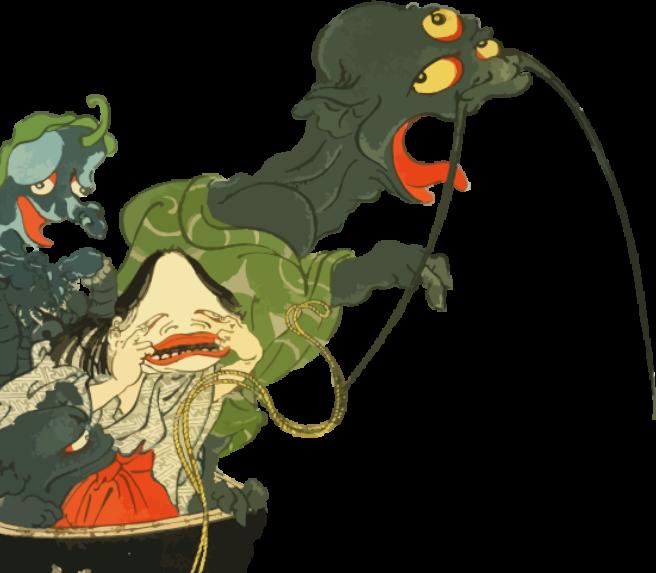

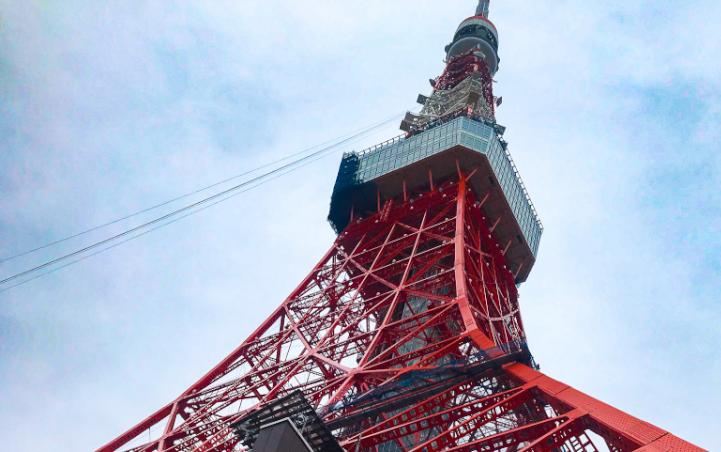
Úna O’Shea (Ishikawa)
It can be difficult to find opportunities to develop new skills or further your career. However, there are always opportunities to learn, and the Japan Market Expansion Competition (JMEC) is one such place.
Now in its 31st year, JMEC started as a joint venture between the Australian and New Zealand Chambers of Commerce in Japan. Currently, it is sponsored by 16 Chambers of Commerce and attracts businesses and participants from all over the world.
JMEC is a competition where participants work in groups to prepare a business plan for a foreign company that wishes to enter or expand in the Japanese market. The programme runs for seven months from November until May. Nele Duprix—Assistant Programme Director of JMEC, describes it as a “mini MBA,” as participants first attend lectures and learn the necessary skills before working in groups to prepare a business plan. The teams with the top three business plans win prizes, and those with particularly standout ideas can win spot prizes.
As the Japanese market and the needs of foreign companies in it constantly change, so does the content of the programme. Ms. Duprix explained that generally, there are core subjects such as finance, marketing, and how to write a business plan.
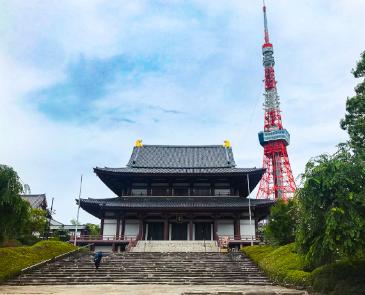

However, topical subjects such as the use of AI in business and social media tactics have been introduced in recent years. Moreover, lectures are taught by a range of people, from university lecturers to industry professionals.

JMEC combines classroom-style teaching with the opportunity to gain real experience. A participant in JMEC 2023, Sam Keane— Coordinator for International Relations (CIR) and Prefectural Advisor in Gifu prefecture, said that they could learn the ins and outs of running a business, not just from textbooks, but while getting realworld experience.
be an opportunity to meet other
Furthermore, it can English-speaking professionals and make connections with foreign businesses in Japan. Another former participant, Harumi Kanaya— Legal Secretary at an international law firm, spoke of the value of learning from specialists who could share their knowledge, gained through years of experience.
The JMEC website describes the average participant as a mid-level participant in their mid-30s. However, Ms. Duprix says that diversity is key for JMEC’s success as it can lead to outof-the-box thinking, so they accept participants from many different nationalities and fields. She said the most important characteristics are to be open and interested.
The businesses that take part also come from a wide variety of fields with very different requirements, and they value the creativity of JMEC participants. Ms. Kanaya mentioned that a highlight of the programme is meeting people from different backgrounds, and noted that many participants were interested in starting their own businesses in the future.
As a result, anyone living in Japan with at least business-level English and a strong interest in learning and developing their professional skills is encouraged to apply. Mr. Keane also mentioned that one of the most surprising things about the programme was learning about how his previous experience as a CIR could be used in the world of business, and he recommended the programme to anyone who wants to try something new.


This competition is designed for professionals in Japan. All lectures are held on Saturdays in a hybrid format: in-person in Tokyo with participants from around Japan also joining online.
Furthermore, all lectures are also recorded for those who cannot attend live. Accessibility is important to the programme to ensure that the participants can get the most out of it, while working full time.

Of course, this is quite a commitment alongside a usual workload. The lectures take place across seven Saturdays between November and January expecting some preparation in between. The business plan groups are assigned after the last lecture, with Ms. Duprix noting the average workload is about 10 hours per week. While attendance in person is never compulsory, it is encouraged to attend at least one lecture in person. It is up to each group to decide their schedule. While accessibility for those all throughout Japan is important, all live events are held in Tokyo, and it is important to take this into consideration if you are based far from Tokyo.
Period: November - June
Application Deadline: October 15, 2024
Price: ¥150,000
Prize: flights with Finnair to Europe, an HP tablet and membership to the American Chamber of Commerce Japan
Commitment: around 10 hours per week For more information, check the JMEC website https://jmec.gr.jp/
About the Author: Úna is a third-year ALT in rural Ishikawa Prefecture. Originally from Ireland, she studied International Studies in The Netherlands and developed an interest in international business relations. Since coming to Japan, she has enjoyed travelling across the country, but particularly the Shinjuku baseball batting centre.
Photo by fauxels: https://www.pexels.com/photo/ photo-of-people-near-wooden-table-3184418/
Photo by Christina Morillo: https://www.pexels. com/photo/photo-of-woman-pointing-on-white-paper-1181487/
Photo by Lukas: https://www.pexels.com/photo/ close-up-photo-of-survey-spreadsheet-590022/
Photo by Cameron Casey: https://www.pexels.com/ photo/low-angle-photography-of-airplane-1157255/
COMMUNITY EDITOR
Tori Bender
Chai tea lattes and skateboarding constantly. Also really loving Novo Amor’s music for the fall vibes.
COMMUNITY DESIGNER
Vaughn McDougall
I've gotten back into the Ace Attorney series once again and the original trilogy are just as fun on the fourth playthrough as they were the first time!
COMMUNITY COPY EDITOR
Aidan Koch
Lately, I've been reading Slam Dunk for Japanese practice. Lots of great characters and enjoying even for a non-sports person like me.
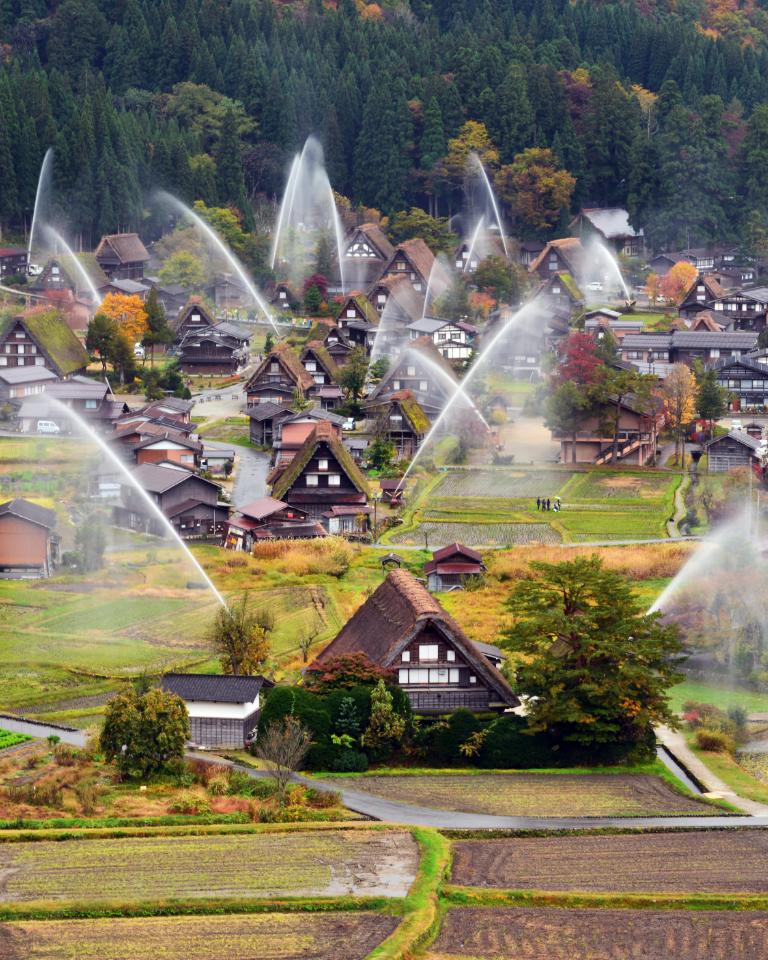
TRAVEL EDITOR
Jon Solmundson
The YouTube algorithm is dragging me down a rabbit hole that leads to me getting way back into Lego as an adult, and only the eye-watering price of those plastic bricks is holding me back from indulgence.
TRAVEL DESIGNER
Jessica Barton Pesto the Penguin.
TRAVEL COPY EDITOR
Kaitlin Stanton
I’ve been playing a lot of Stardew Valley! I try to line up the in-game season with the season happening in real life, emphasis on the “try.”
Tori Bender (Hyogo)
軒下, Nokishita—under the eaves.
Nestled in the quirky town of Kasai, about 30 minutes by car from Himeji City in Hyogo Prefecture, is an even quirkier shop, with a name that makes one think, what lies under the eaves?
The answer to this question can be found in the eclectic mix of customers and the odd little decorative details located on and inside the shop building, which happens to be inside a kominka—an old, traditional Japanese house.

Now in its tenth year, with opening hours Thursday and Friday evenings and Saturday afternoons, it’s easy to make the assumption that Nokishita is simply another weekend cafe-bar.
Nokishita, however, goes against the grain by hosting its own unique subculture—a mix of retro antiques, a night cafe featuring local coffee, and occasional sobauchi nights with fresh soba noodles made on location.
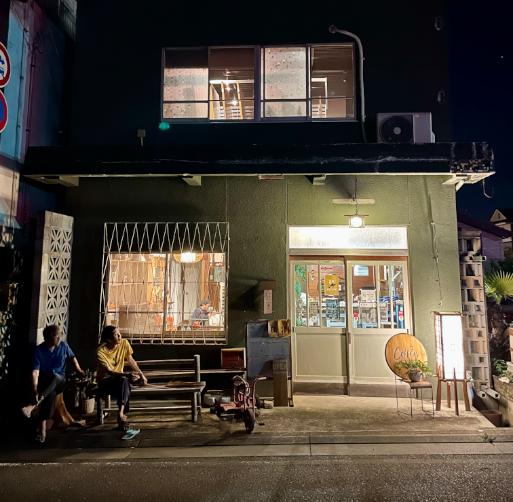
If chill lo-fi beats were a place, this would be it.
Located directly across from an AEON shopping center, Nokishita’s green exterior and outdoor foliage are a welcome sight. It’s impossible to miss from Kasai’s busiest road, with the name in hand-painted graffiti facing the streetside wall. On the front of the building, the owner Miyashita’s eccentric personality is first apparent on the eave of the first floor—the edge of the roof that sticks out over the wall. The corner of the eave, which had once crumbled off, has been replaced entirely with legos.
Upon entering Nokishita, it’s difficult to focus on just one thing. Houseplants and retro decorative goods line the walls, while customers lounge about on brightly-colored furniture which might have been pulled straight out of a 1960’s magazine. The smell of coffee and fresh-baked muffins fills the air, prepared by Madoka, who runs the cafe portion of the shop. Sitting down to enjoy a muffin or an iced coffee in itself is an experience due to the quaint and ever-rotating furniture. When asked what exactly is being sold in the
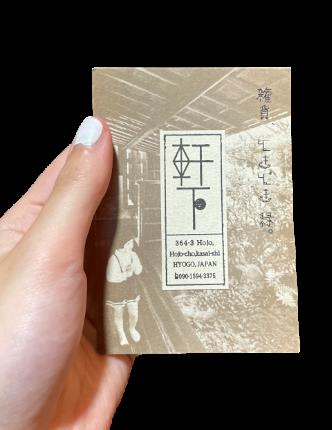
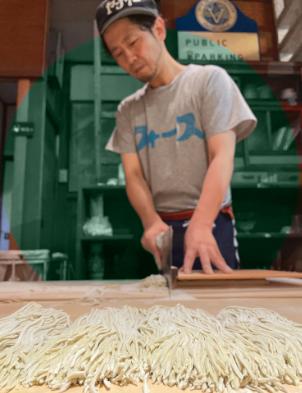
From cute cacti to wonky wind-up toys
Miyashita’s interests essentially all come together in Nokishita. Aside from running the shop, he often works as a gardener, trimming trees and plants in traditional-style Japanese gardens, as well as making original karesansui Japanese rock gardens—and tsuboniwa—a small, enclosed mini-garden. Nokishita is often filled with a variety of foliage available for purchase as well.
In addition to plants, the shop’s many shelves are lined with unique pottery, glassware, and other household items. It is particularly difficult to ignore the shelf of incredibly old toy figures which look like they were pulled out of a 100year-old time capsule, and which also speak when you tug on the back levers.
The furniture Miyashita finds is unlike anything you’d find at your local shopping center. Everything brought in has an incredible amount of character.
“I collect things from people I know and acquaintances,” Miyashita says when asked how he finds the things he sells.


Retro goods, gardening, muffins, and . . . soba?
Walk into Nokishita on the right night and you may find someone making soba (buckwheat) noodles by hand. This would be none other than local soba enthusiast Matsushita Hideki.
Matsushita has been making soba as a hobby and hosting various soba-making events in the central Hyogo community for several years, including around two years at Nokishita, where he turns soba from powder to chilled noodles in the center of the shop.
Most impressively, Matsushita has passed the fourth rank of the zenmenkyou (All-Japan Noodle Association) soba-making test, the highest rank being rank five. Sobauchi is a long and intricate process with several steps, so this is no mean feat. When you walk into Nokishita and find Hideki-san mixing soba by hand, you know you are in for a very special treat.

What really makes a place is the people you find in it. Snacks and oddities aside, the customers of Nokishita will make sure you do not forget them: antique collectors; coffee roasters; artists and illustrators; local skateboarders; motorcyclists; and restaurant owners. The people who return to the shop will leave a lasting impact on you. Everyone has a unique story waiting to be heard. Everyone is connected and awaiting the arrival of new faces.
“No matter who you are, people from all aspects of life are welcome,”
Miyashita tells CONNECT. “That’s what I’d like to tell the [Englishspeaking community] in Japan. This is a traditional home in which people from all aspects of life come together.”
Madoka adds with a laugh. “There are many strange people here, so please come and join us if you’d like.”

is a
and editor
She loves mountains, rivers, and the Japanese countryside. In her free time she likes to paint, skateboard, and watch movies. She is happiest around close friends and with her mischievous orange cat, Sora.
Tori’s Instagram
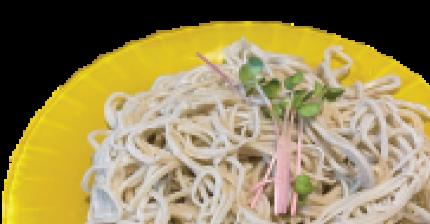

Arashi Danjiro is a dynamic force who weaves his diverse talents into a vibrant tapestry of creativity and athleticism. As a professional wrestler, he captures audiences with his impressive moves and engaging presence, building a career that has soared since his university days. His creativity also shines through in his work as a graphic designer, where he creates visuals that are both striking and imaginative.
In the seaside town of Miyazu, Kyoto, Danjiro channels his passions into Top Rope Shot Bar, where his love for wrestling and anime come together in a space that reflects his personality. Filled with wrestling memorabilia and anime-inspired decor, the bar offers guests a one-of-a-kind experience shaped by Danjiro's creative vision. Whether he is performing in the ring, designing graphics, or running his distinctive bar, Danjiro’s life is a celebration of his many talents and
What inspired you to become a wrestler, and how did your journey in wrestling begin?
I graduated from Kyoto Saga University of Arts with a degree in Japanese painting. One day, I had the opportunity to watch a professional wrestling match and felt that professional wrestling was both a martial art and an art form, so I decided to take up wrestling. hat I have actually met.

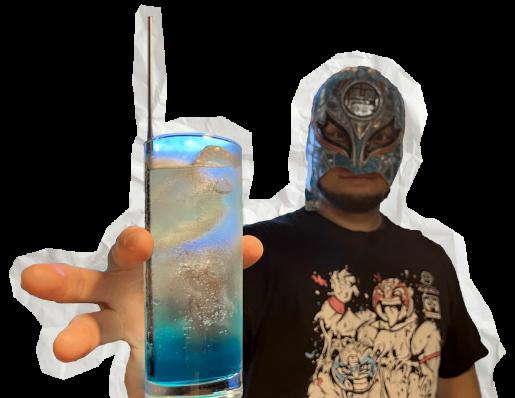

How did you transition from being a wrestler to owning a bar? What motivated that decision?
Since graduating, I have always been a professional wrestler, not as a job, but as a volunteer. Before owning Top Rope Bar, I worked as a designer in Osaka. In 2017, when I returned to my hometown of Ayabe City, Kyoto Prefecture, I decided to become a business owner. I had never worked at a bar before, but I wanted to try something new, so I decided to open a bar.
Can you describe the atmosphere and theme of your bar? How does your wrestling career influence its design and ambiance?
The theme is not completely about professional wrestling, but also anime and other Japanese subcultures in general! The theme is subculture, but we are particular about alcohol, and it's a simple bar that you can enjoy!
What are some of your most cherished wrestling memorabilia in the bar, and is there a story behind any of them?
There are items that will delight wrestling fans, such as a replica Tiger Mask mask and a bronze statue of Antonio Inoki. There are also autographs of famous wrestlers on display, such as Tatsumi Fujinami, Great Kabuki, and Master Wato! Most of the autographs are from wrestlers that I have actually met. There is also an autograph from Yoshio Itoi, a former professional
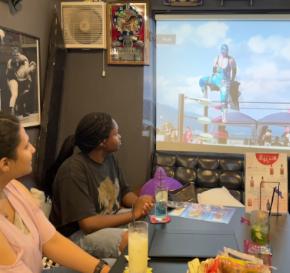

baseball player from Yosano, Kyoto!!
How does the local community in Miyazu respond to your bar and your wrestling background?
It all started with a request from Hachi House, a guesthouse in Miyazu, to hold a small wrestling event! From there, various people got involved, and we held a big event in Miyazu. Many of our guests saw me wrestling for the first time in person!

How has the journey of being a wrestler and a bar owner impacted you personally? What have you learned along the way?
As a wrestler, my life has expanded into a world I've never seen before. I've been able to meet many different people and travel to places I've never been.
I've also been able to experience many things that I would never have been able to experience if I hadn't become a wrestler! As a bar owner, I meet a lot of customers and listen to their stories, which broadens my world. I feel like it has enriched my life!
What advice would you give to someone who wants to pursue a passion, whether it’s wrestling, running a bar, or something else entirely?
It's important to try anything you want to do! I also think it's essential to understand the local area and the people involved in what you want to do.
How do you see the future of your bar and wrestling career? Any plans or dreams you’re working towards?
I would like to continue at my own pace, little by little, increasing my recognition (as a bar owner and professional wrestler). I want to continue performing professional wrestling as my artistic endeavor for a long time. My dream is to still be a professional wrestler into my 50s!
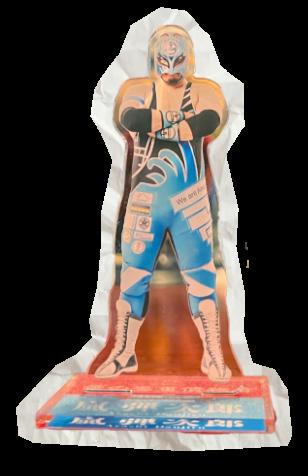
Arashi Danjiro is a multi-talented professional wrestler and graphic designer who brings his creative flair to the ring and beyond. As the owner of Top Rope Shot Bar in Miyazu, Kyoto, he combines his passion for wrestling with a unique bar experience. Come visit his bar for the electric atmosphere and follow him on Instagram @bar_toprope

Taylor Hamada is an elementary school teacher and content creator in the countryside of Northern Kyoto. She loves her community on the Sea of Japan and enjoys reading, writing, and playing with her cat. You can find her on Instagram @tanoshiitravel
Sophie McCarthy (Tokyo)
When tourists envision their trip to Japan, the iconic shinkansen or bullet train, often takes center stage. Yet, beyond the sleek, high-speed marvels of modern engineering, Japan boasts a delightful array of transportation options that are often overlooked.

From the charming, city trams still clattering through cities across the country, to the quaint ferries shuttling between the countless small islands dotting the coastlines and the Seto Inland Sea, there are endless ways to celebrate the joy of the journey itself. While the cost and speed of bullet trains and planes have undeniable appeal, these alternative modes of travel offer a unique charm where the voyage becomes an experience in its own right.
First, consider Japan’s last remaining overnight sleeper train, the Sunrise Express, which whisks passengers from Tokyo to southern Honshu. The train splits into two routes—the Sunrise Seto and the Sunrise Izumo—at Okayama, with one heading toward Takamatsu, Kagawa and the other toward Izumo, Shimane. The return trip to Tokyo arrives at a comfortable 7 a.m., particularly convenient when compared against the many night buses that arrive very early in the morning (sometimes even before the subway is running). For those with different travel plans, there are also midnight stops in Kobe and Osaka. Best of all, the Japan Rail Pass covers the train’s base fare.



As for accommodations, the Sunrise Express presents a semi-private dormitory-style option called the nobi nobi zaseki (stretch and relax seat), which features carpeted bunks. For those seeking more privacy, single and twin bunk private rooms are available, with the upper bunks providing stunning views through large, curved windows. Onboard amenities include public showers, vending machines, and lounges with window-side tables and chairs. However, there is no dining car, so it is advisable to bring snacks.
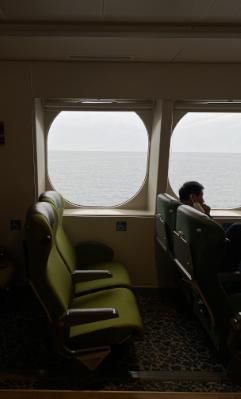
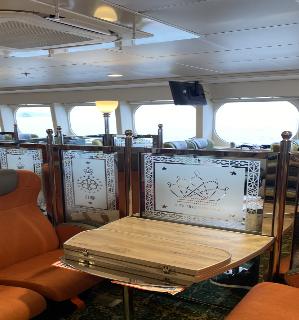

Riding the Sunrise Express feels like stepping back in time, where the pace is slower and the journey is savored. The train serves as a nostalgic experience rather than a means of swift travel, attracting a diverse crowd of passengers eager to relive a bygone era of train travel. The experience is so captivating that falling asleep might seem like a missed opportunity, as every moment of this unique ride promises something special.
For international travel, JR’s Beetle Ferry offers a distinct alternative to its more common air route, operating multiple times daily between Fukuoka, Japan and Busan, South Korea. This ferry provides a serene and calming passage, a welcome contrast to the hectic environment of international airports. With a travel time of around three hours, the Beetle not only guarantees gorgeous views of the Korea Strait, but also features a restaurant and a duty-free shop onboard.
The Fukuoka ferry port is about a 20-minute bus ride from Hakata Station, or a more convenient 5 to 10-minute taxi ride, depending on traffic. On the Busan side, the international ferry terminal is ideally located just in front of Busan Station—a major transportation hub connecting subway lines and high-speed rail—making it less than a 10-minute walk away. Unlike flights, the Beetle only requires arrival an hour before departure, allowing for a more relaxed start to the journey with extra time to sleep in, prepare, and set off on schedule.
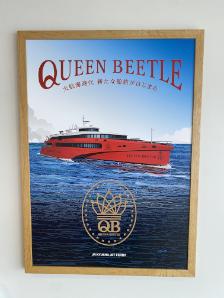
Various open seating options are available, from cozy sets of four chairs around a table to comfortable row seats and dining tables. Passengers can stretch their legs and visit the onboard restaurant, pick up a drink from a vending machine, or enjoy a freshly brewed coffee from specialized coffee dispensers.
The tranquility of the ride, along with the freedom to stroll around and gaze through the large glass windows, allows passengers to truly appreciate the voyage and connect with the surrounding landscape. As the Beetle glides toward South Korea, the sight of tiny islands gradually giving way to towering apartment buildings creates a captivating experience, with the landscape unfolding slowly and almost magically before the eyes.
So much time is spent moving from point A to B, whether in daily routines or during travel. This time shouldn’t be seen as lost or wasted, but as an integral part of the adventure itself. To truly enrich the travel experience, it’s essential to consciously choose modes of transportation that offer not just efficiency, but also the opportunity to savor the moments in between, reminding us that the journey is as meaningful as the destination.
Sophie McCarthy was a JET for four years in Kobe, Hyogo Prefecture (2018-2022). She now lives in Tokyo. In her free time, she enjoys reading, visiting kissaten, and practicing film photography. Check out her photos on Instagram: @filmbysophie

Discovering the rich reds and golds in the green heart of Japan
Alicia Goh (Gifu)
Gifu is one of Japan’s eight landlocked prefectures and its seventh largest prefecture. What it lacks in seaside bounties it makes up with pristine rivers, soaring mountainside views, a fairytale-like hamlet of gassho-zukuri (thatchroof) houses, and many traditional crafts protected and passed down for generations: Seki cutlery, Mino ware pottery, and Mino washi paper. But come autumn, its central position—nestled in amongst the mountains— offers something of a hidden treasure for travellers seeking the colours of the season. From north to south, Gifu spans a vast range of altitudes, which means that the viewing window for the cherry blossoms of spring and the momiji (red maple leaves) of autumn last far longer here than in other prefectures.
Less than two hours by rail from Osaka or Kyoto, or about two and a half hours from Tokyo, the autumnal scenery of Gifu is accessible even to those who’ve waited until the last moment to plan their momiji-viewing. It’s a place of small crowds, delicious food, friendly locals, and a deep love for the environment. With October’s arrival, now is the perfect chance to take a look at the prefecture’s top scenic spots of the season.
Okuhida Hot Spring Villages (Takayama)
奥飛騨温泉郷(高山市) Okuhida Onsen-kyo (Takayama-shi)
Peak autumn-viewing: early to late October
Tucked away in the Northern Japan Alps (also known as the Hida Mountains), the Okuhida Hot Spring Villages have the highest number of open-air hot spring baths in Japan. The mountains are bathed in brocades of amber and red during autumn, the sights and sounds of the forest providing the perfect accompaniment to a soak in the onsen.
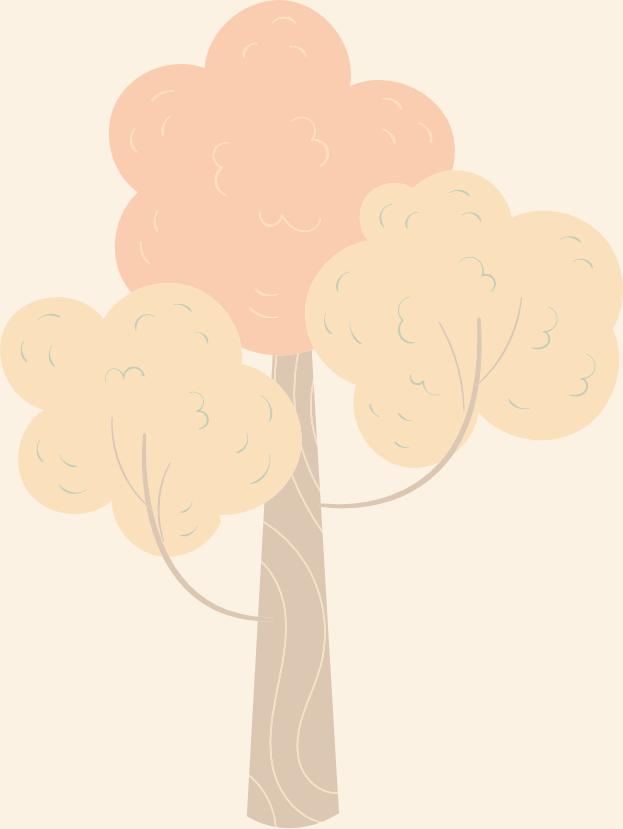

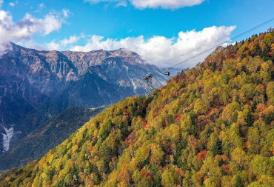

2The nearby Shinhotaka Ropeway is Japan’s only double-decker aerial tramway, with an unparalleled panoramic view of the Northern Japan Alps throughout the year. However, for the autumn season, operating hours are extended, allowing travellers to see the sunset and starry night sky at 2,156 m above sea level.
& みじ谷(美濃市) Oyada-jinja & Miji-tani (Mino-shi)
Peak autumn-viewing: mid to late November
Located in Central Gifu, Oyada Shrine is a Shinto shrine built in 1672, enclosed by a primaeval forest of over 3,000 maple trees, some of which are over 1,000 years old. The site is widely recognised for its importance, with the shrine listed as a National Important Cultural Property and the forest itself designated as a Natural Monument of Japan. Cloaked in deep crimsons come mid-November, the scenery of the autumn foliage is a sharp contrast to the intricate wooden carvings that adorn the shrine, making it a popular spot for photographers.
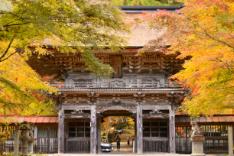
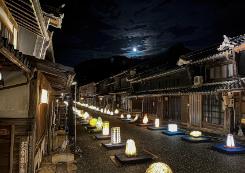
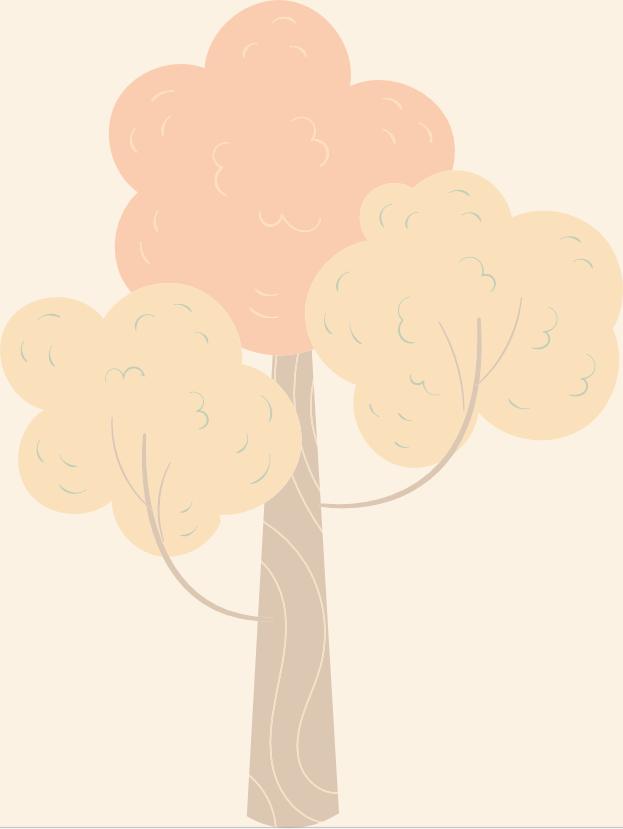
The shrine is also the venue for the local Hinkoko Festival, where a 500 year-old puppet performance takes place, enacted as a prayer for good harvest and spiritual cleansing. The puppets are brought out on the third Saturday and Sunday of October and during the Maple Valley Festival (the last Sunday of November).
Not too far away, the Udatsu Wall Historical District of Mino City hosts the Mino Washi Akari Art Festival from mid-October until early December.
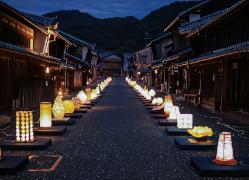
Paper lantern art from all across the country and some from overseas is displayed in the town, adding to the beauty of its structures—which have retained the look and feel of Japan’s Edo period. At sunset, gentle light shines through the delicate Mino washi paper decorations, fashioned into all manner of shapes and sizes.
Peak autumn-viewing: mid to late November



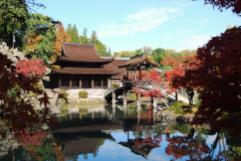
In Gifu’s southeast, you can find Eiho-ji Temple, a Rinzai Zen Buddhist temple with a garden designated as a National Scenic Place of Beauty. The 700 year-old giant gingko tree in front of the main hall bursts into bright gold during the autumn season, combining with the fiery hues of the Japanese maples and the bright blue sky to create a sight that must be seen in person.
Tajimi has also held a reputation as the centre of production for Mino wares for the past 1,000 years, so fittingly the ceramic lanterns here are all made with local shino and oribe glaze styles.
Those with a deeper interest in ceramic art, or a curiosity for unique architecture, may also want to wander over to the Mosaic Tile Museum. The exterior, created by architect Fujimori Terunobu, is not one that’s easy to forget, modelled after the quarries from which the clay for the mosaic pieces are carved. Inside, as well as examples of tile work dating all the way back to the start of the Showa era, guests are able to make their own tile handicrafts too.

4

慈恩禅寺(郡上市)Jion-zenji (Gujo-shi)
Peak autumn-viewing: late October to early November
On Central Gifu’s western edge lies Jion-zenji Temple, complete with a stunning garden designed to showcase the beauty of the changing seasons. Visitors are welcome to have a seat facing the garden while relaxing to the soothing sounds of the running waterfall and the suikinkutsu, a traditional Japanese garden ornament that amplifies a trickle of water (in Jion-zenji’s case, from the temple’s washing basin) into a jar to create constant, natural music. The myriad colours and carefully cultivated trails create an effect that’s not all too different from walking through a real-life scroll painting.
However, as a “strolling pond garden” the grounds are best enjoyed while wandering the path, admiring the changes in the scenery with each step, pausing to contemplate the garden from a variety of perspectives rather than focusing on any one view.
The garden was created in the style of the Muromachi period, though the current buildings are not quite that old. The originals were destroyed following a flood in 1893, but were thankfully rebuilt three years later.
5
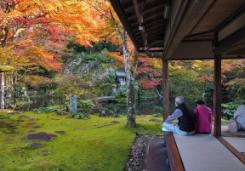
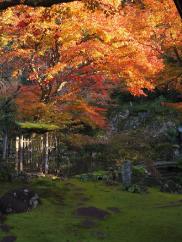
学びの森(各務原市)Manabinomori (Kamigahara-shi)
Peak autumn-viewing: mid to late November
Down in South Gifu, 70 gingko trees make up the “Forest of Learning.” Spread out over 300 m, these trees put on a dazzling show every year in autumn, attracting many visitors from far and wide.


The foliage arcs over the road, creating a seemingly endless tunnel of rich golden hues. The promenade also carries a second name, the “Winter Sonata street,” as it was a filming location for the wildly popular Korean drama of the same name back in 2002. While an autumn visit is the best way to appreciate the trees’ natural beauty, those making later travel plans can also set their trip between early December until mid-February, when the trees are decked out when the trees are decked out in 200,000 fairy lights to create a winter light spectacle.

From the untouched wilderness of the Hida Mountains to the vast, rich Nobi Plains in Kakamigahara, Gifu’s autumn has something for everyone to enjoy, and that goes far beyond just the places listed here. Dotted throughout the prefecture are countless glimpses of Japan’s cultural history and natural wonders. One autumn would never be enough to see them all, but it might just be a good time to start.
Alicia Goh is a Malaysian Chinese Australian who works in tourism marketing and likes to promote the hidden parts of Gifu on the side. Among the things she enjoys are singing, jogging (after, not necessarily during), boxing, and cross-stitching. Unwitting subjects of her burgeoning interest in photography include insects, flowers, and adorably round wild birds. She also likes lists.
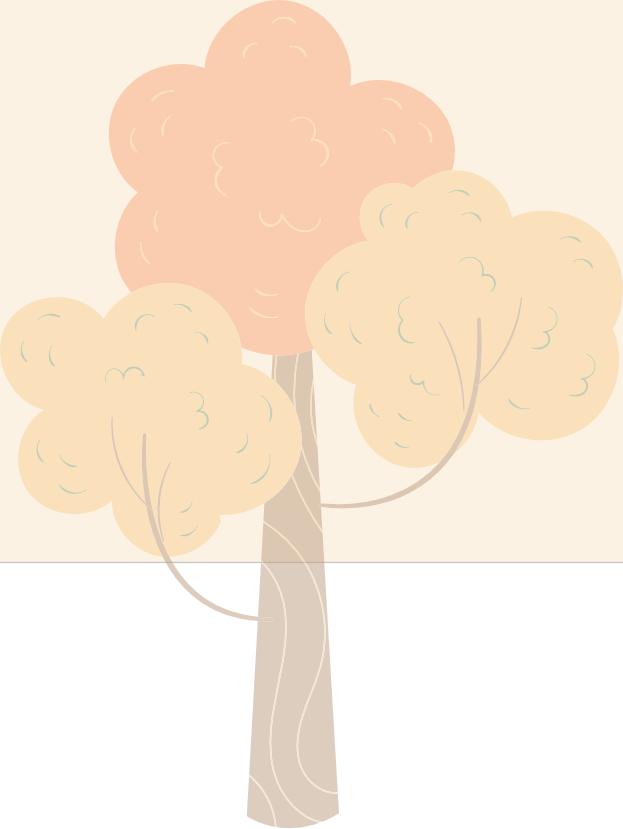
CONNECT is a magazine for the English-speaking community in Japan, by that very community. Everyone is welcome to write, no matter your experience or style! If you have an idea you want to see in these pages, please reach out to our Head Editor, or any of the amazing Section Editors. We'll work with you to make it the best it can be and share it with our audience of thousands. Whether it's an essay, an interview, infographics, great photo spreads, or even just your favourite recipe reach out to us!
Contact the Head Editor of CONNECT, Mike Taylor, at connect.editor@ajet.net, with your submissions, comments and questions.
Write about something you're doing, something you love, or even just a cool piece of history that you're interested in. Tell us a story.
Tell us about someone in your community who is doing something neat and noteworthy. Cooks, collectors, calligraphers we want to hear about the inspiring people around you!
If you're an aspiring photographer and want your work published, please get in touch with our Head Designer, Renee Stinson at visualmedia.connect@ajet.net
Let us know what you think. Interact with us on Facebook, Twitter and issuu.com
Have an article you want to share? Join our Contributors Page on Facebook to stay connected with the team so you can share your adventures whenever story strikes!
Interested in contributing to CONNECT? Want to stay up-to-date on interview opportunities, photo requests, and CONNECT announcements? Get involved with CONNECT by contacting our current CONNECT staff and reading about the possible positions here
You can also like us on Facebook, follow us on Instagram, and interact with the magazine via CLIP at ISSUU.